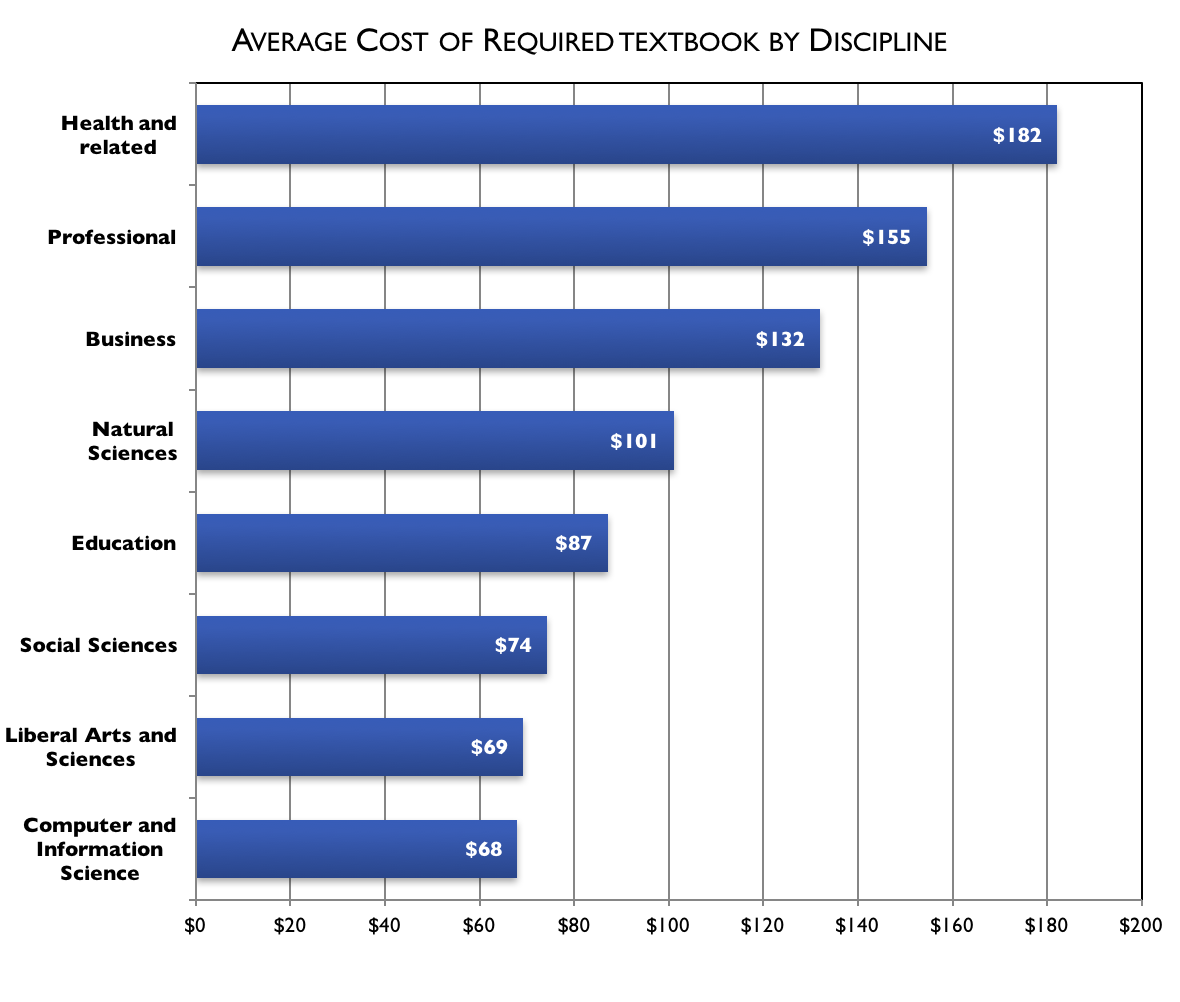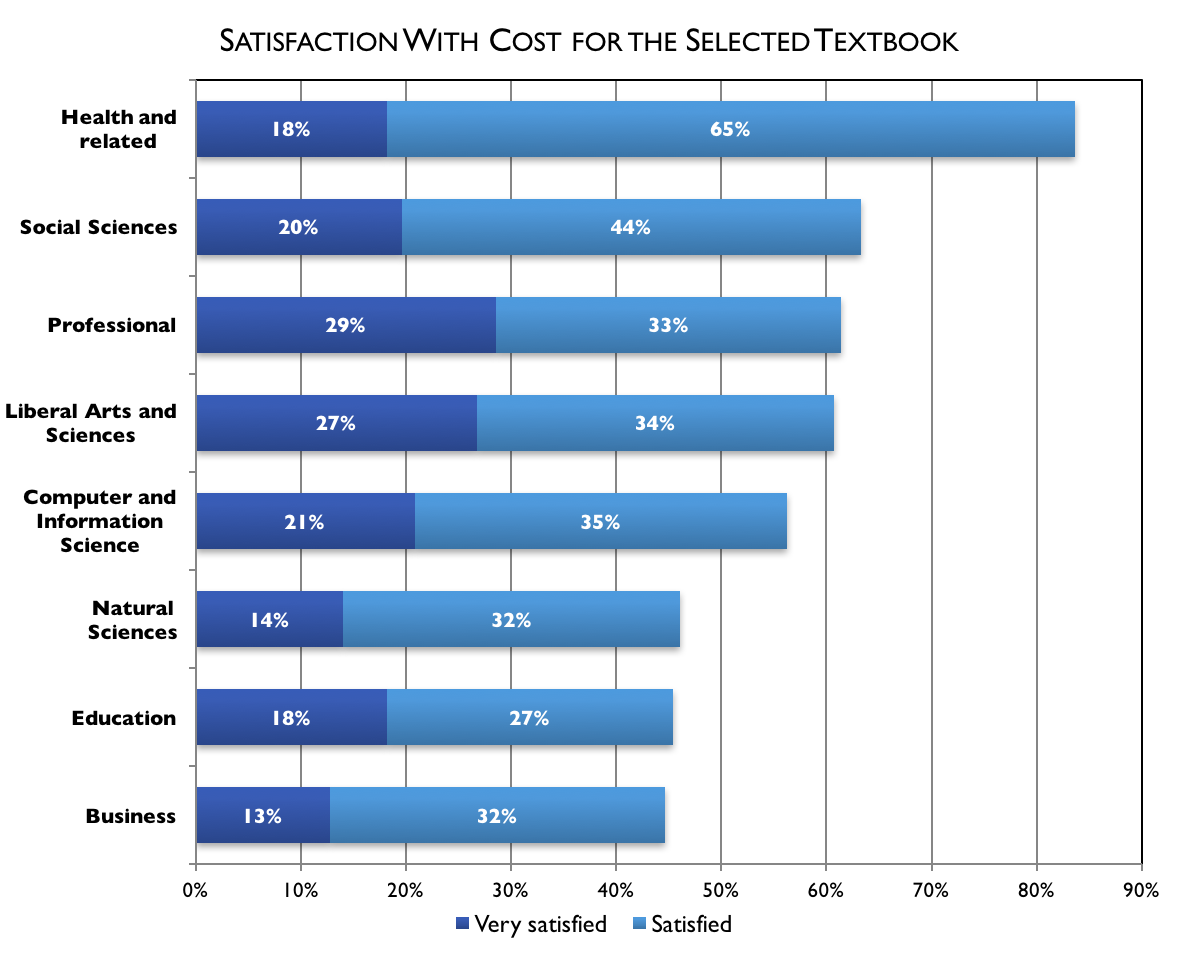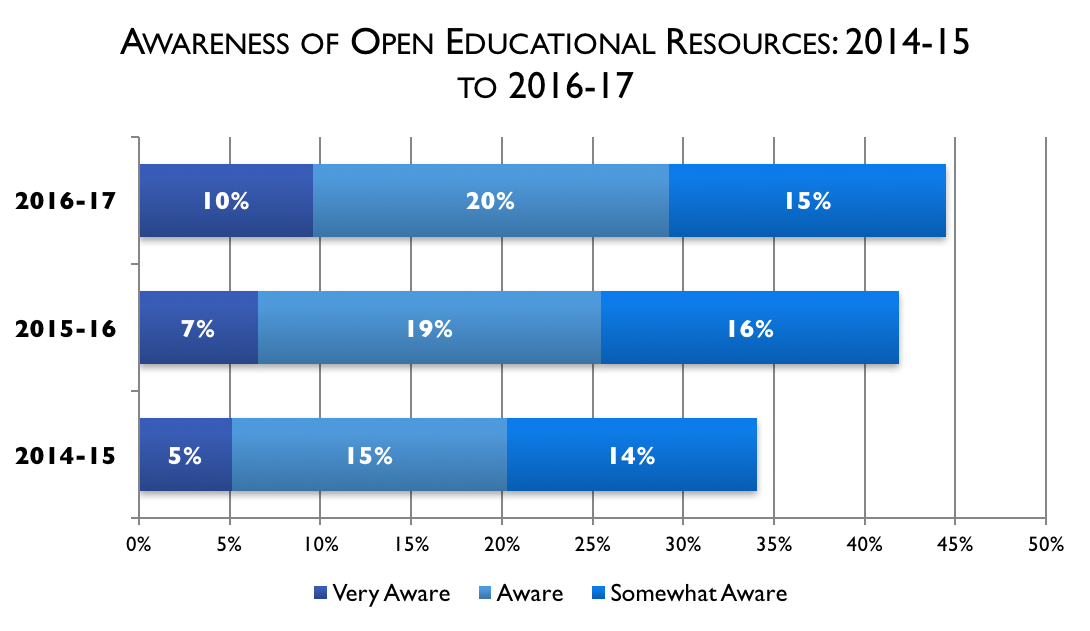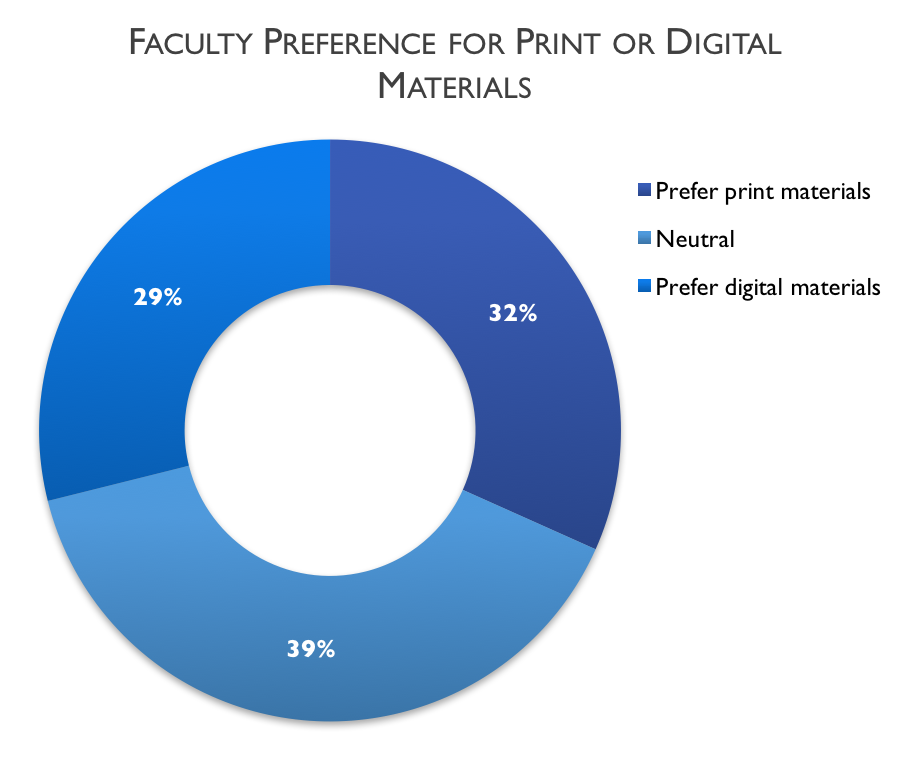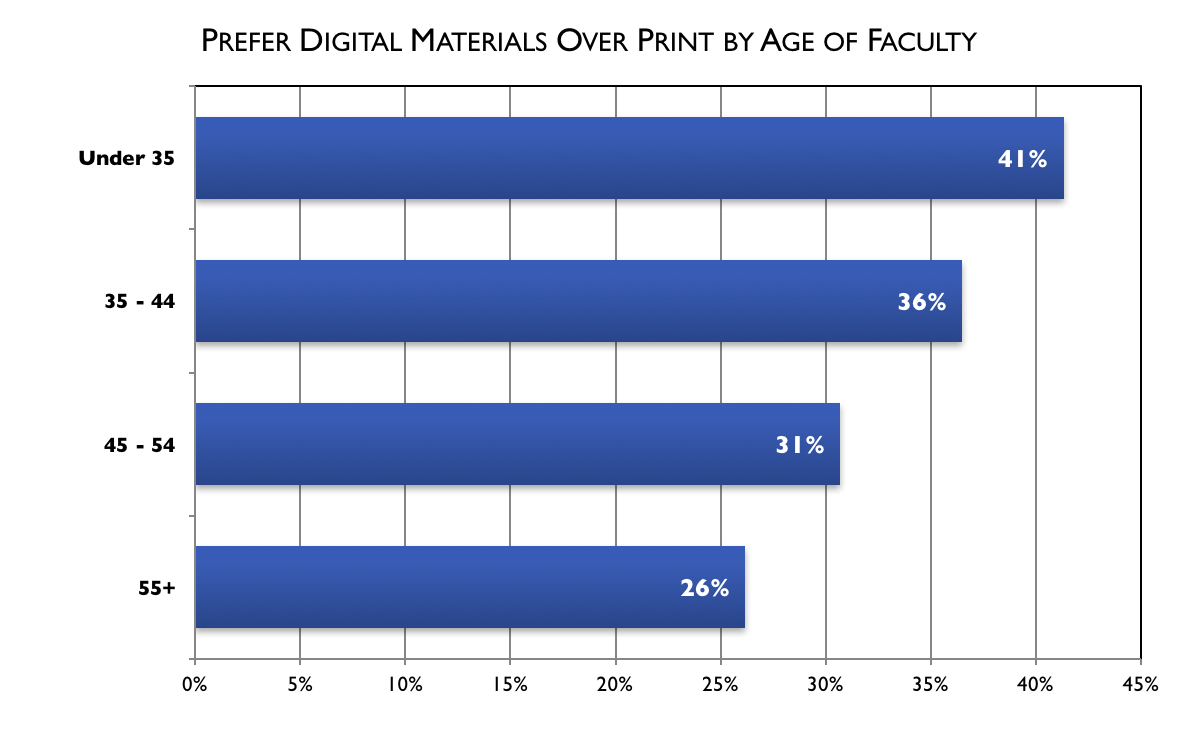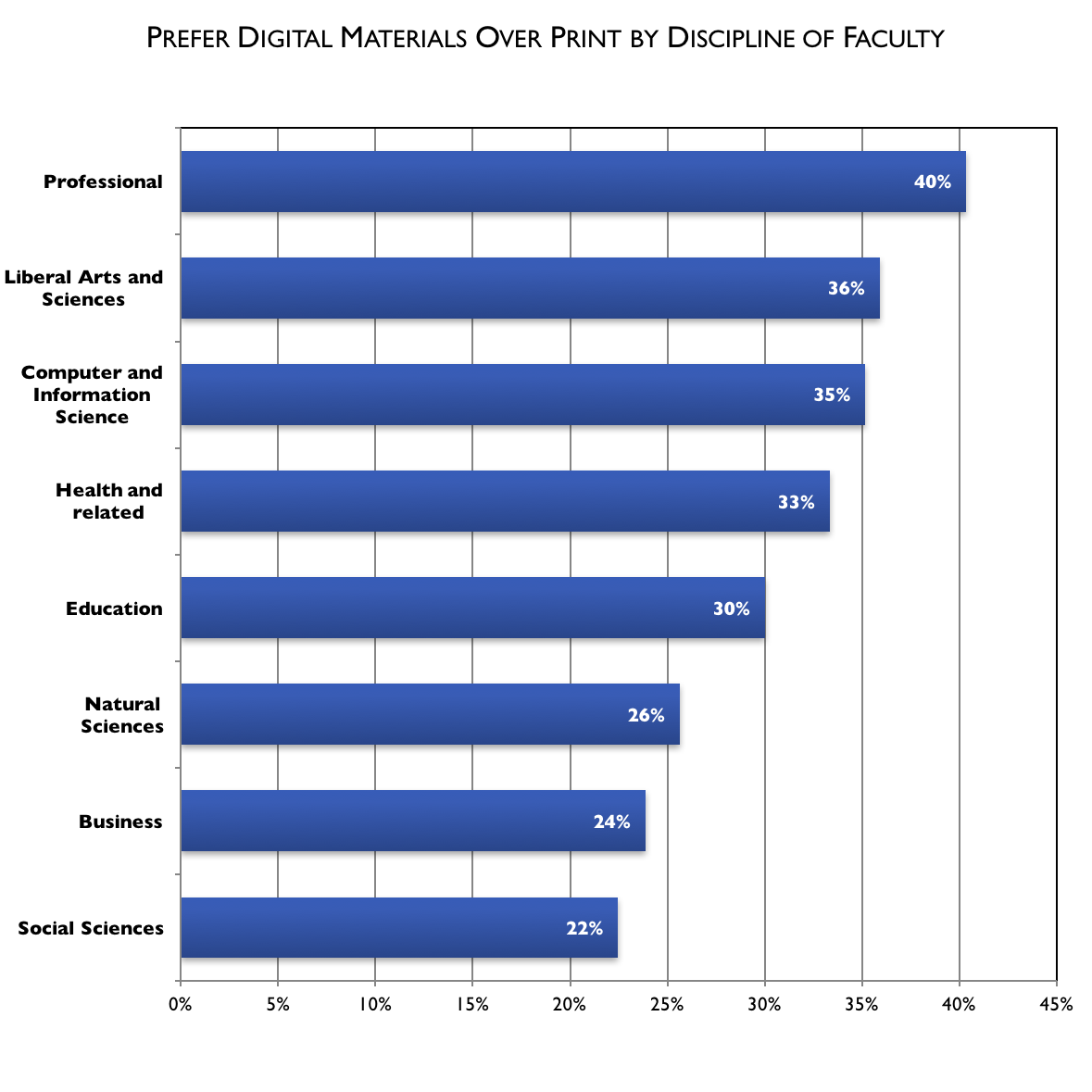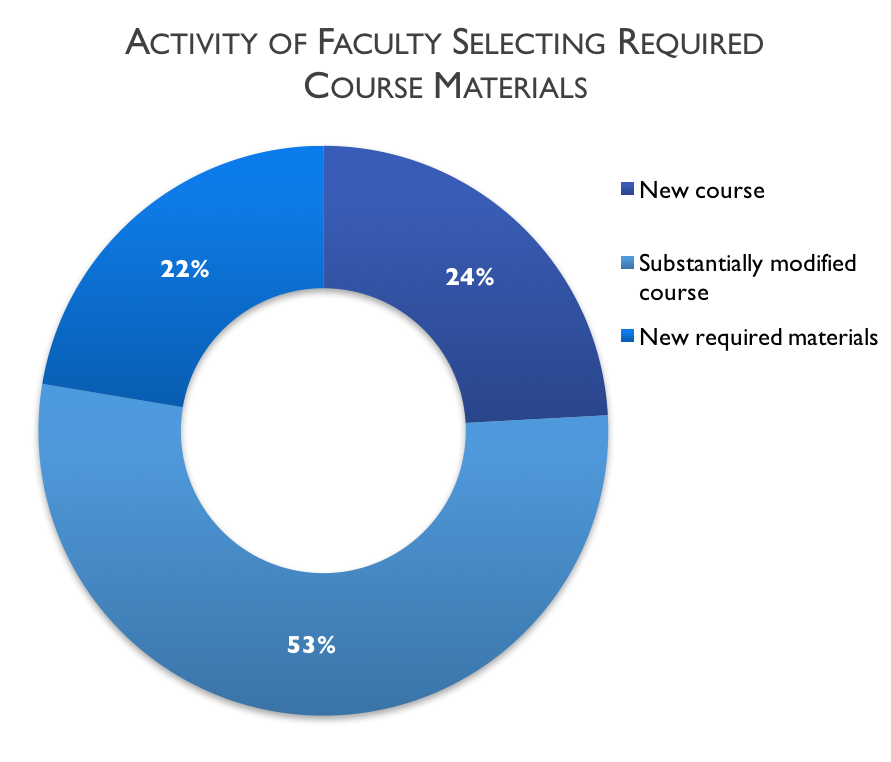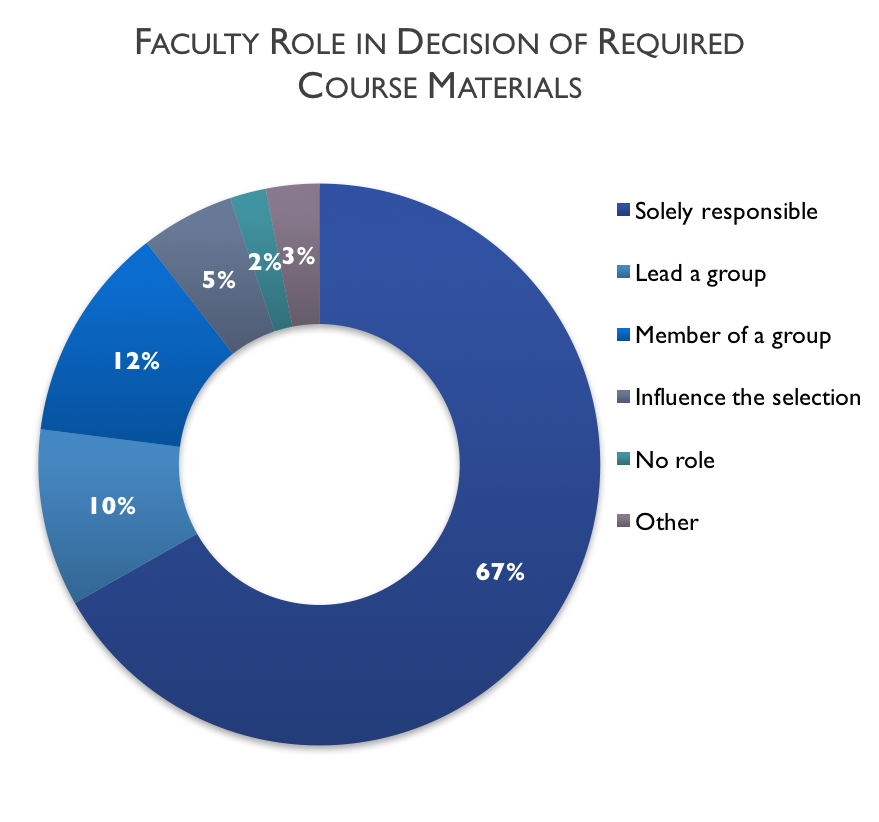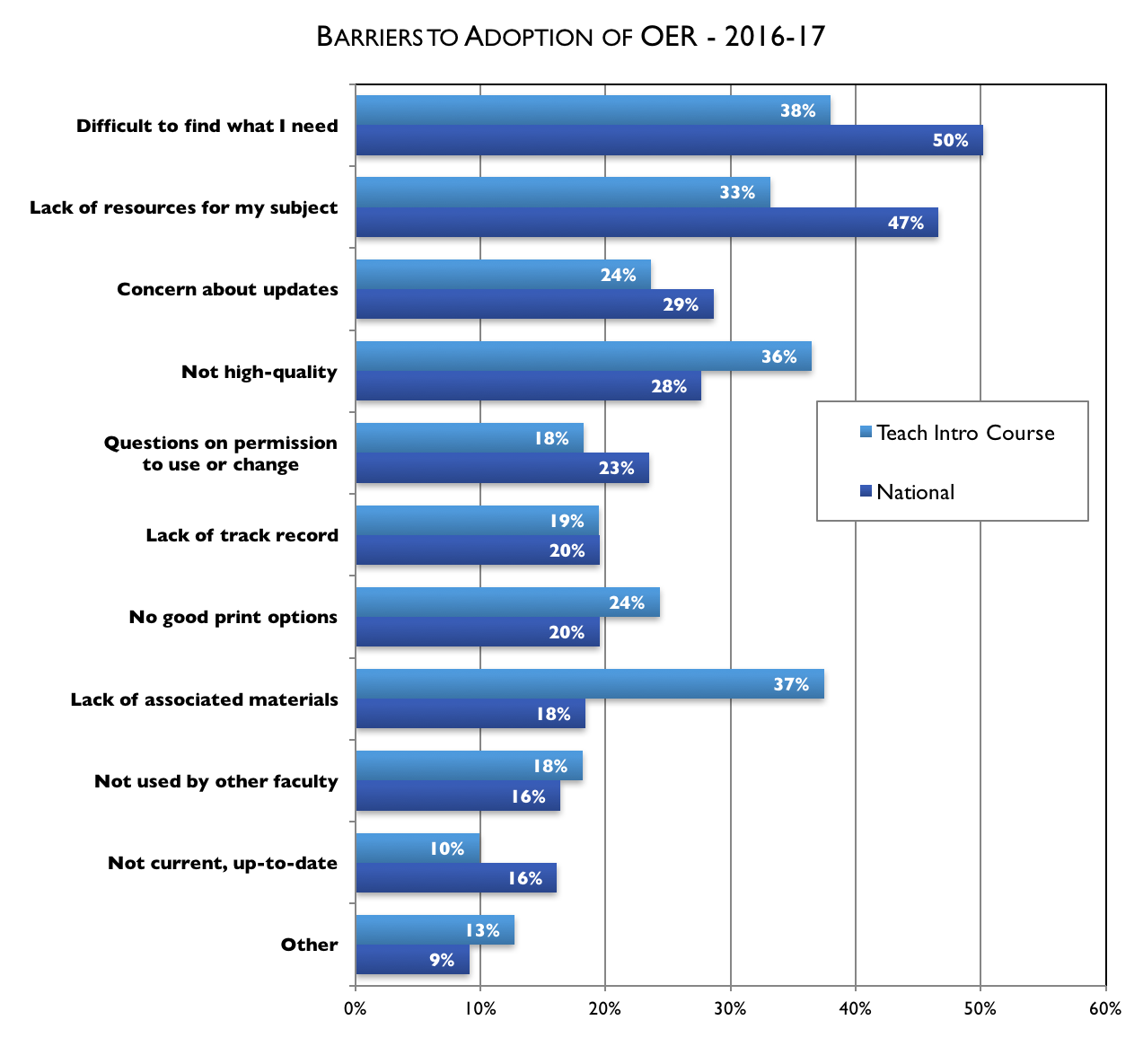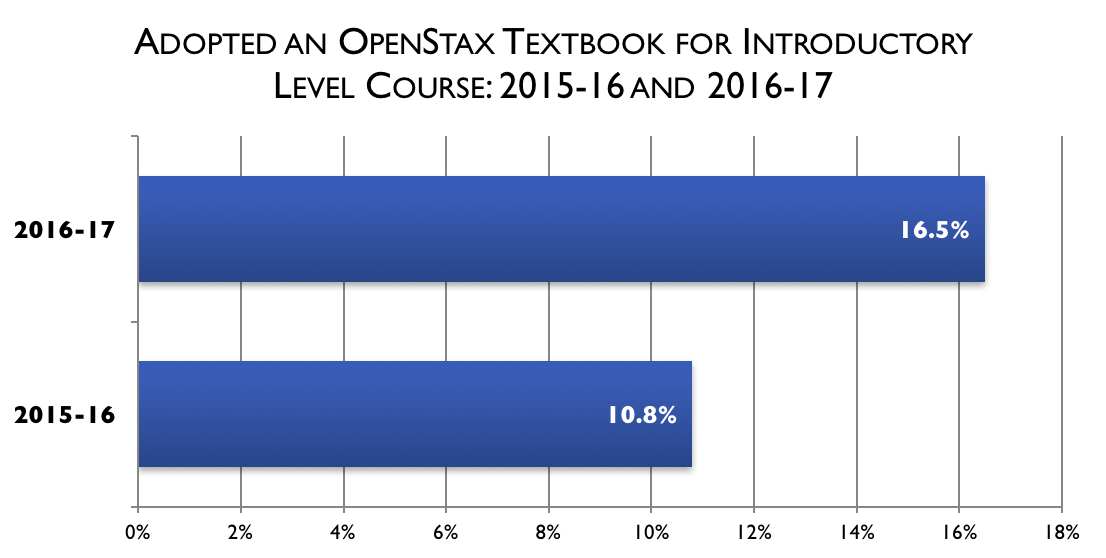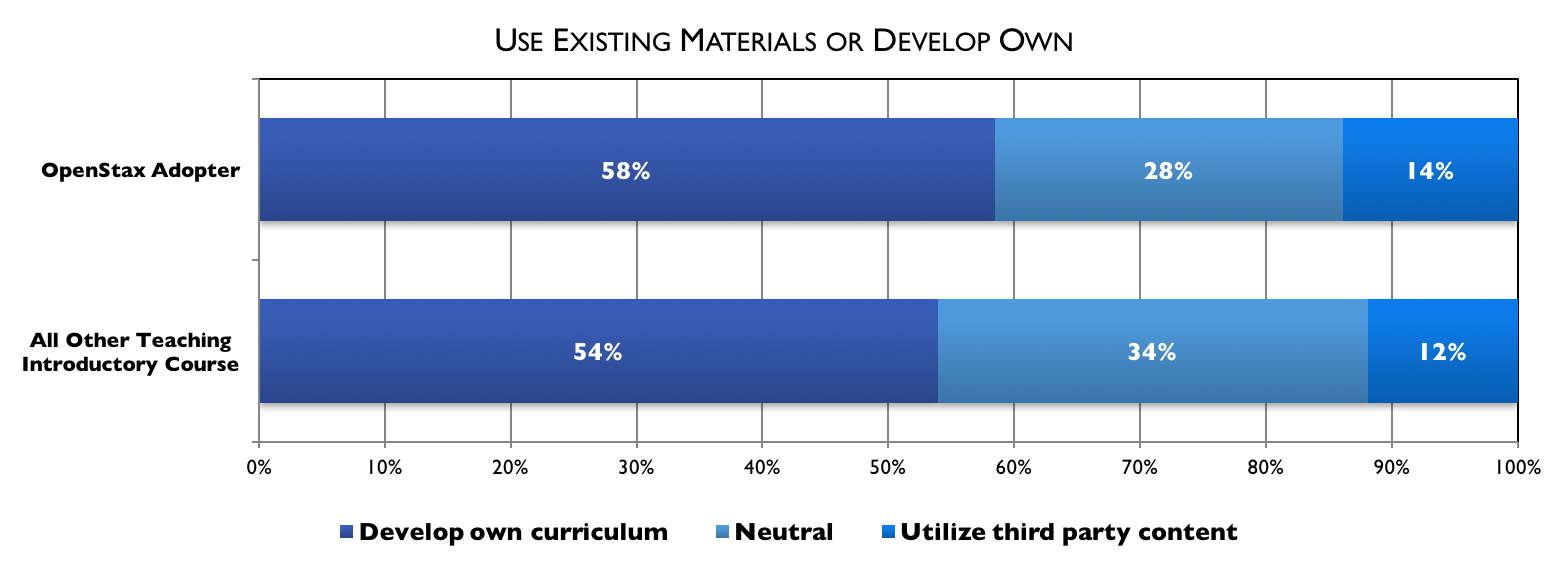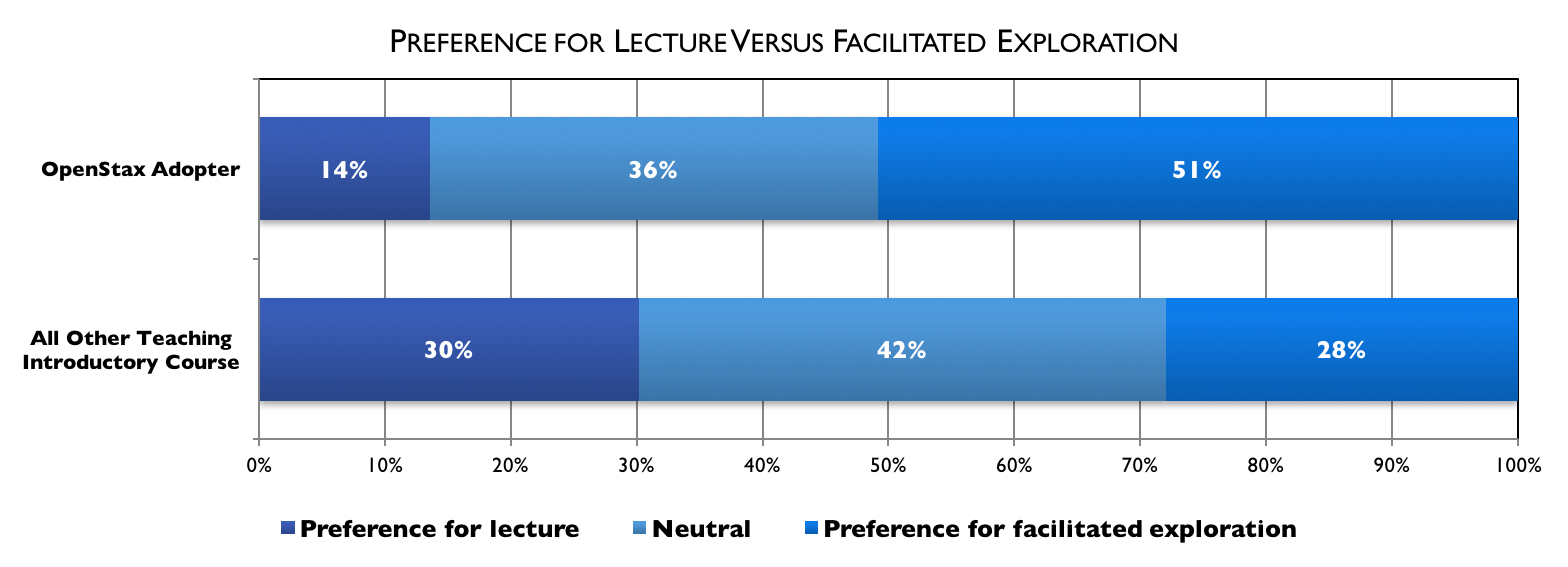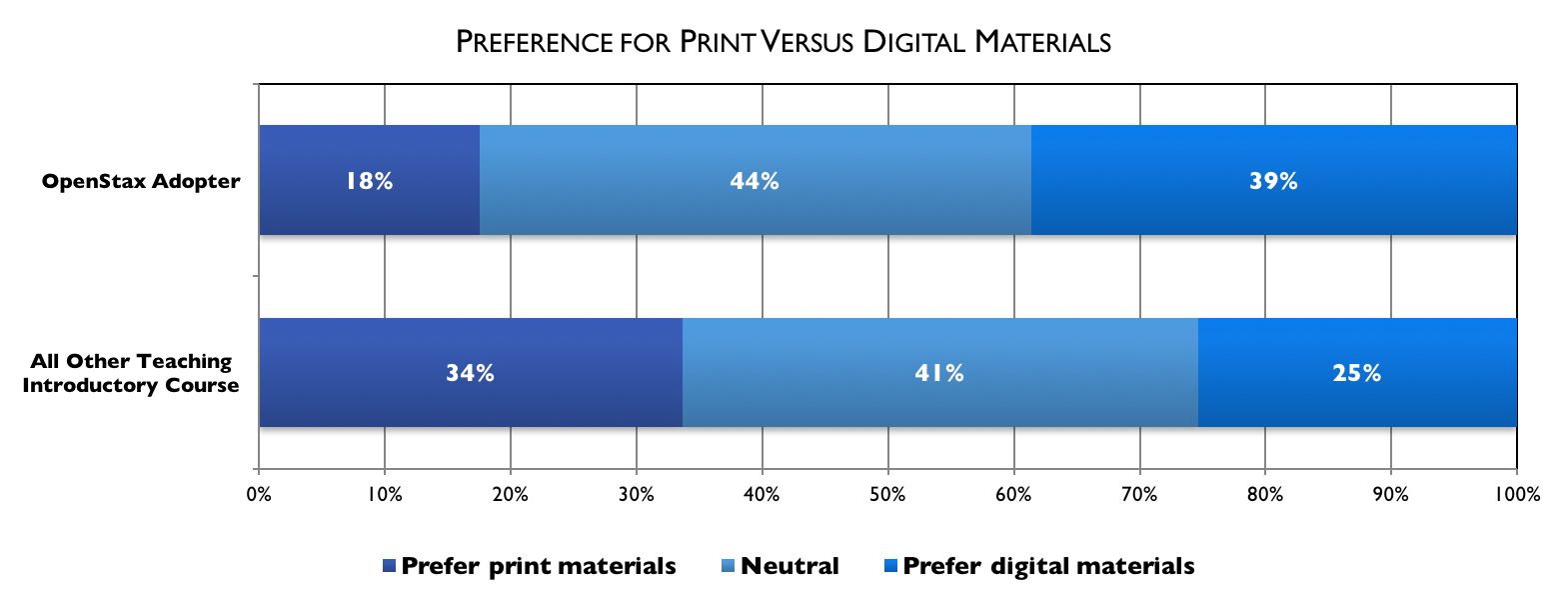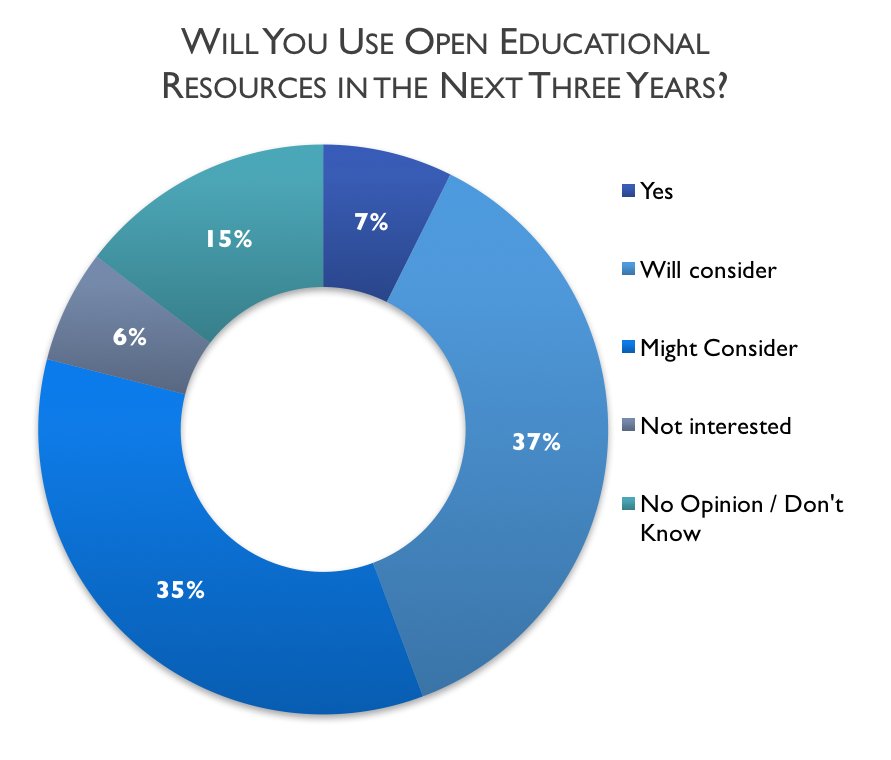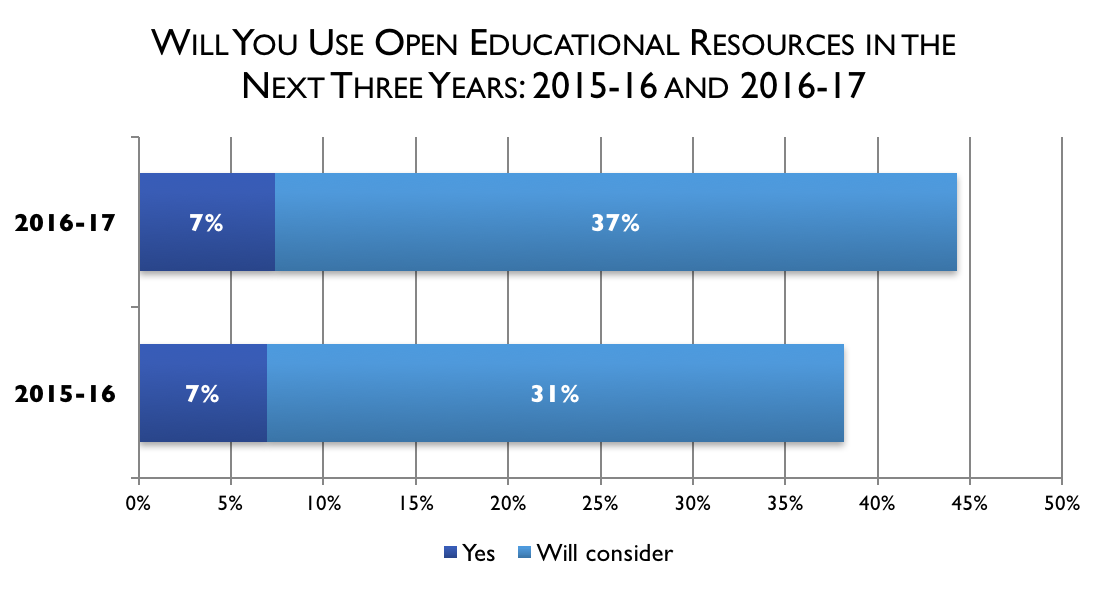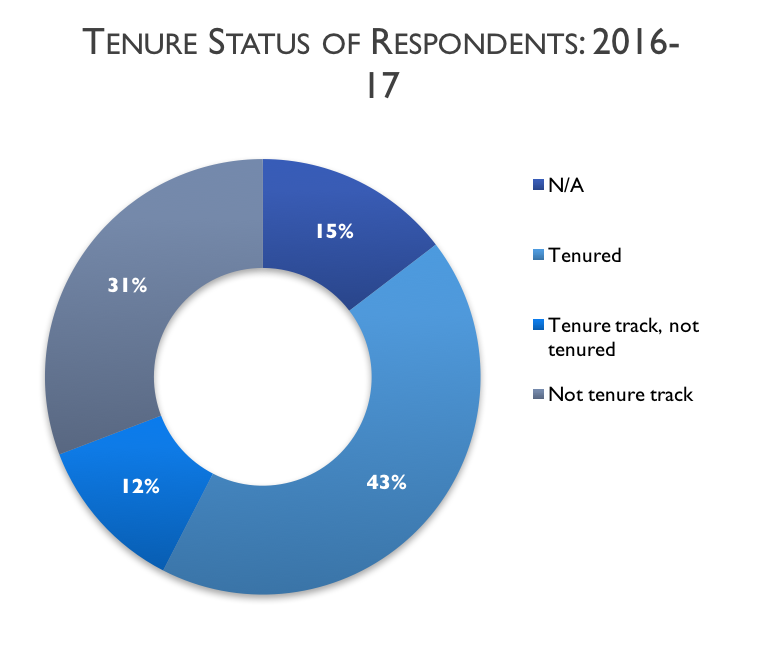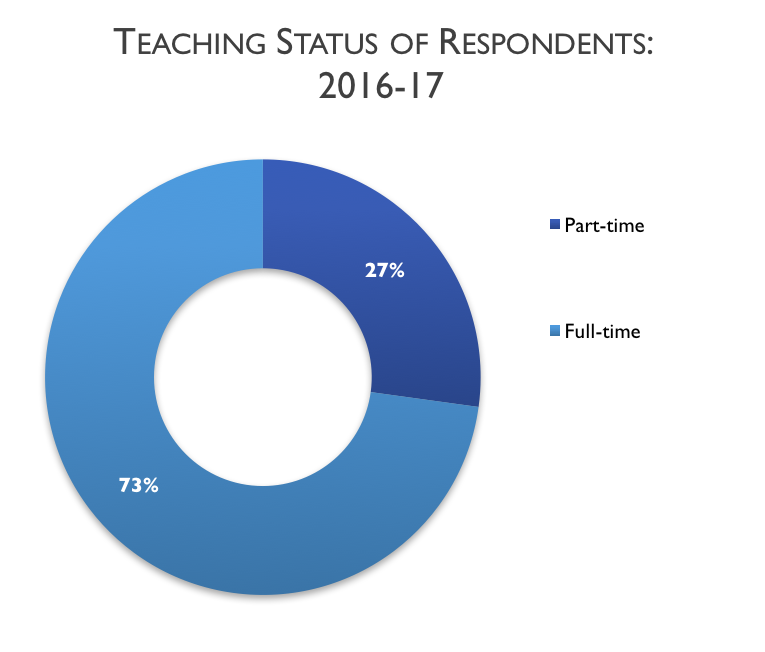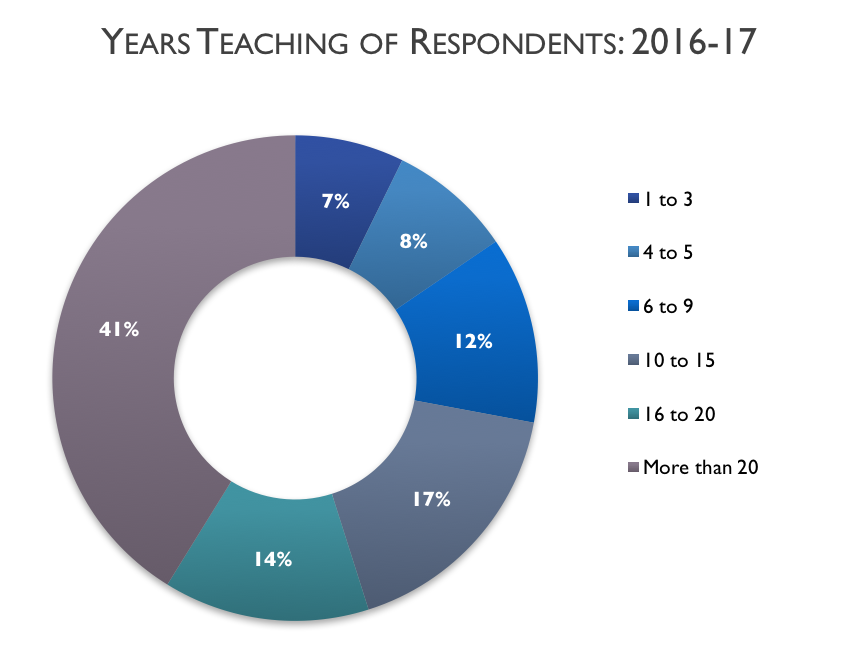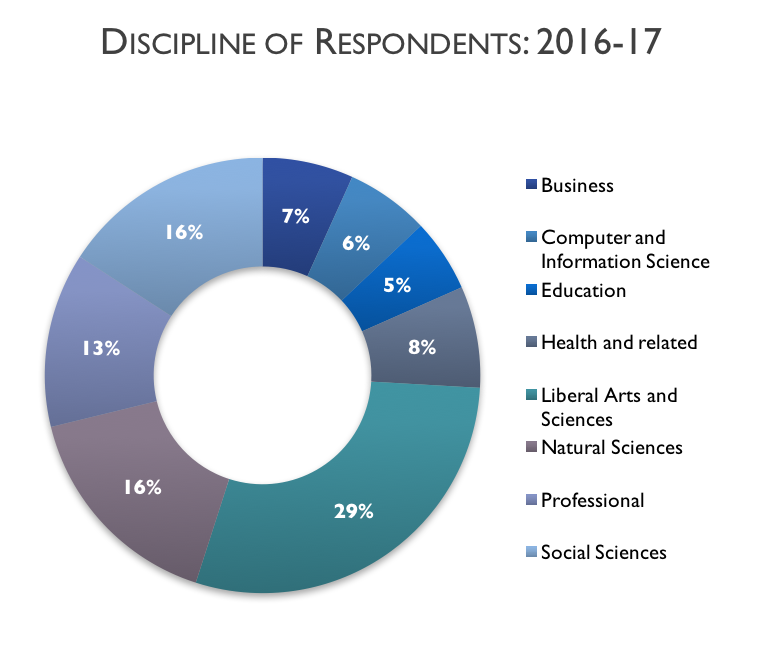ACKNOWLEDGMENTS
This research would not be possible without the assistance
of a number of organizations. First, we wish to thank the William and Flora
Hewlett Foundation for their considerable help in framing the project, as well
as their support of the data collection, analysis, and report creation. Their
background and knowledge of open educational resources and contacts within the
OER community was invaluable in defining the focus of the study. We also wish
to thank the Global Healthy Living Foundation for their support in the
administration of the Hewlett Foundation grant.
This report presents results derived from a nationally representative
sample of higher education faculty. In addition to providing responses to a
wide range of questions, these faculty also provided thousands of comments and
observations on the state of teaching and learning. Each section of this
report includes a selection of faculty quotes relevant to that topic. These
quotes are presented as close to the original as possible, with the only
changes being the correction of typos and the removal of any personally
identifying information.
We wish to thank the thousands of faculty members who took
the time to provide us with these detailed and thoughtful responses. We
understand that you are very busy people, and appreciate your effort. This
report would not be possible without you, and we hope that you find it useful.
Julia E. Seaman
Jeff Seaman
Babson Survey Research Group
2017
EXECUTIVE SUMMARY
Responses from over 2,700 U.S. faculty paint both a
"Good news" and a "Bad news" picture for the role of open
educational resources (OER) in U.S. higher education. Both sides of the
equation are clearly evident in the responses from higher education teaching
faculty who had recently selected required curricula materials (primarily
textbooks) their course.
To begin with the bad news: the levels of awareness of
OER, the licensing tied to it, and overall adoption of OER materials, remains
low. Only 10% of faculty reported that they were “Very aware” of open
educational resources, with 20% saying that they were “Aware.” Awareness of Creative
Commons licensing also remains low, with only 19% of faculty reporting that
they are "Very aware." Measures that combine both dimensions are
even lower, with 8% classified as "Very aware" and 17% as
"Aware" on a joint measure of OER and of Creative Commons licensing
awareness.
Faculty continue to report significant barriers to OER
adoption. The most serious issues continue
to be the effort needed to find and evaluate suitable material. Nearly one-half
of all faculty report that “there are not enough resources for my subject”
(47%), and it is “too hard to find what I need” (50%). In light of this, the
reported level of adoption of open-licensed textbooks (defined as either public
domain or Creative Commons) of only 9% is not a surprise. Many faculty members
also voice concerns about the long-term viability of open educational
resources, and worry about who will keep the materials current.
That said, there is
also considerable cause for optimism among those who support OER. The
awareness and adoption levels may be low, but they also show steady
year-to-year improvements. For example, the open-licensed textbook adoption
rate of 9% for 2016-17 represents a substantial increase over the rate of 5% for
2015-16. Likewise, awareness of both Creative Commons licensing and OER itself
has increased each year.
OER also addresses a key concern of many faculty: the cost
of materials. A majority of faculty classify cost as "Very important"
for their selection of required course materials. Faculty report that their
required textbooks have an average price of $97, and only 22% say that they are
"Very satisfied" with that cost. It is therefore not surprising that
most faculty report that not all of their students buy all the required texts
for their class, with only a third saying that 90% or more of their students
have purchased the required textbook.
A particular area of
OER success is among large enrollment introductory-level courses. These
courses touch the largest numbers of students, are often taught in multiple
sections (66%), and are typically required for some subset of students (79%).
Faculty teaching these courses were presented with a list of the most commonly
used commercial textbooks (up to twelve) for their specific course, along with
an open text alternative from OpenStax, a non-profit OER publisher based out of
Rice University.
The rate of adoption of OpenStax textbooks among faculty
teaching large enrollment courses is now at 16.5%, a rate which rivals that of
most commercial textbooks. This is a substantial increase over the rate
observed last year (10.8%). Users of OpenStax textbooks also had levels of
satisfaction equal to their peers teaching introductory level courses who had
selected commercial textbooks. These adoptions address concerns about cost as
well: faculty who did not select an OpenStax textbook reported an average cost
of $125 for the required textbook, while those who did select an OpenStax text
reported an average cost of $31.
The OpenStax results
among large enrollment introductory-level courses shows that OER can be
successful. OpenStax has been able to reach penetration levels equal to most
of their commercial competitors, with equal levels of faculty satisfaction, in
a very short time. This comes amid continuing concerns on the part of faculty
about the limited nature of OER materials, particularly the lack of associated
materials like tests, quizzes, and homework assignments, that are typically
provided by commercial alternatives.
The OpenStax model has also successfully addressed another
faculty concern: the desire for print over digital. Faculty continue to report
that their students prefer printed materials, and OpenStax provides this
alternative in addition to a freely distributed digital version.
The results show that when you deal directly with the top
faculty concerns of finding and evaluating potential OER options, OER can be as
successful as commercial alternatives. OpenStax has done this by using an
adoption and distribution model that is very similar to that of commercial
publishers, with nicely formatted printed copies available for students in
their normal bookstore.
One lesson from the OpenStax results is that you need to
reach individual faculty members in order to be successful. Two-thirds (67%)
of all faculty reported that they were the sole decision maker for the new or
revised course material, while an additional 22% of faculty engaged in a group
decision. Faculty have a well-proven model for selecting their teaching
materials, and any new player will have to be successful within that model.
OpenStax’s success is
not complete, however. Initial adoption has primarily been among faculty who
are willing to embrace new teaching styles, have greater willingness to move
away from the traditional lecture style for teaching, and have a higher
appreciation for digital materials. It is unclear if faculty with more
traditional approaches, or greater reliance on associated materials, will
follow in the same numbers.
It is also not clear if
the OpenStax model will work outside of large enrollment classes. A mature OER
distribution channel stocked with well-developed, high-quality options can
address two of the most common factors cited by faculty when selecting
educational resources: the need for comprehensive content and resources that
are easy to find. OER has a district advantage for the remaining top concern:
the cost to the student. Questions remain, however. Will there be sufficient
adoption in smaller classes to support the production and updating of OER textbook
alternatives? Is there enough volume in this market to support other OER
publishers?
Definitions
This study is designed to explore the process by which
faculty members select the educational materials that they employ in their
courses. The most common of these is the required textbook - faculty members typically
select one or more books that all students are required to use through the
duration of the course. Faculty also employ a wide range of other materials:
some optional, others required for all students. This study only deals with required
materials, using the following definition:
Items listed in the course
syllabus as required for all students, either acquired on their own or provided
to all students through a materials fee; examples include printed or digital
textbooks, other course-complete printed (course pack) or digital materials, or
materials such as laboratory supplies
In addition to
examining the overall resource selection process, this study also explores the
particular class of materials classified as open educational resources (OER). The
Hewlett Foundation defines OER as:
OER are teaching, learning,
and research resources that reside in the public domain or have been released
under an intellectual property license that permits their free use and
re-purposing by others. Open educational resources include full courses, course
materials, modules, textbooks, streaming videos, tests, software, and any other
tools, materials, or techniques used to support access to knowledge.
An important aspect of the examination of the use of
educational resources is the licensing status of such materials: who owns the
rights to use and distribute, and does the faculty member have the right to
modify, reuse, or redistribute the content? The legal mechanism that faculty
are most familiar with is that of copyright. As noted by the U.S. Copyright
office, copyright is:
A form of protection provided
by the laws of the United States for "original works of authorship",
including literary, dramatic, musical, architectural, cartographic,
choreographic, pantomimic, pictorial, graphic, sculptural, and audiovisual
creations. "Copyright" literally means the right to copy but has come
to mean that body of exclusive rights granted by law to copyright owners for
protection of their work. … Copyright covers both published and unpublished
works.
Of particular interest
for this study is the copyright status of the primarily textual material
(including textbooks) that faculty select as required materials for their
courses.
Copyright owners have the
right to control the reproduction of their work, including the right to receive
payment for that reproduction. An author may grant or sell those rights to
others, including publishers or recording companies.
Not all material is copyrighted. Some content may be
ineligible for copyright, copyrights may have expired, or authors may have
dedicated their content to the public domain (e.g., using Creative Commons
public domain dedication).
Public domain is a designation
for content that is not protected by any copyright law or other restriction and
may be freely copied, shared, altered and republished by anyone. The
designation means, essentially, that the content belongs to the community at
large.
An intermediate stage
between traditional copyright, with all rights reserved, and public domain,
where no rights are reserved, is provided by Creative Commons licenses. A
Creative Commons license is not an alternative to copyright, but rather a
modification of the traditional copyright license that grants some rights to
the public.
The Creative Commons (CC) open
licenses give everyone from individual authors to governments and institutions
a simple, standardized way to grant copyright permissions to their creative
work. CC licenses allow creators to retain copyright while allowing others to
copy, distribute, and make some uses of their work per the terms of the
license. CC licenses ensure authors get credit (attribution) for their work,
work globally, and last as long as applicable copyright lasts. CC licenses do
not affect freedoms (e.g., fair use rights) that the law grants to users of
creative works otherwise protected by copyright.
The most common way to openly license copyrighted
education materials – making them OER – is to add a Creative Commons license to
the educational resource. CC licenses are standardized, free-to-use, open
copyright licenses.
STUDY RESULTS:
Selecting Educational Resources
"I have deliberately developed the policy for my
courses that students will have no textbooks or any other materials that must
be purchased. All reading materials are digital and accessed online."
(Full-time Social Sciences Faculty)
"As a literature professor, I require my students to
bring their literary texts to every class. I also require that they have actual
physical books (unless a student has an ADA accommodation). One reason is that
recent cognitive research has shown that student understanding and retention is
better when reading words on paper than on screens. I have also found that even
the most tech-savvy students can navigate a book more quickly than they can an
electronic text." (Full-time English Language and Literature Faculty)
"I teach a sophomore level linear algebra course for
which I require/recommend a textbook. But I don’t care which edition they use,
so the cost can vary from $0, for an online pdf of an earlier version they
might find to $142 for a new copy of the latest edition." (Full-time
Computer and Information Science Faculty)
"My main concern with resources for my classroom is
with student use. I find that students 1) do not absorb information when they
read and 2) resist doing assigned reading and 3) a small minority of students
actually purchases required texts, even if there are assignments that require
the text." (Full-time Professional Faculty)
Faculty may recommend
or require particular materials for the students in their courses, ranging from
specific editions to free resources to multiple types of materials. This study
focuses on those that are required, defined as all items "listed in
the course syllabus as required for all students, either acquired on their own
or provided to all students through a materials fee."
The most common item by
far that faculty list on their syllabus as "required" is one or more textbooks,
with 68% of all faculty reporting that they have a required textbook. Other
print materials (e.g., articles and case studies) are required by a majority of
faculty. All other types of materials are required by less than one-quarter of
faculty. Software (22%) and video and film (20%) are required by more faculty
than supplies (15%), calculators (11%), data sets (8%), clicker systems (6%),
or other materials (13%).
Some faculty also list
items which they recommend, but do not require students to purchase. The most
common of these are articles and case studies, which are recommended by 20% of
faculty. There are also recommended textbooks (17%) and videos/films (17%), as
well as recommended software (11%). Only a single digit percentage of faculty
recommend other types of materials, like supplies, data sets, and clickers.
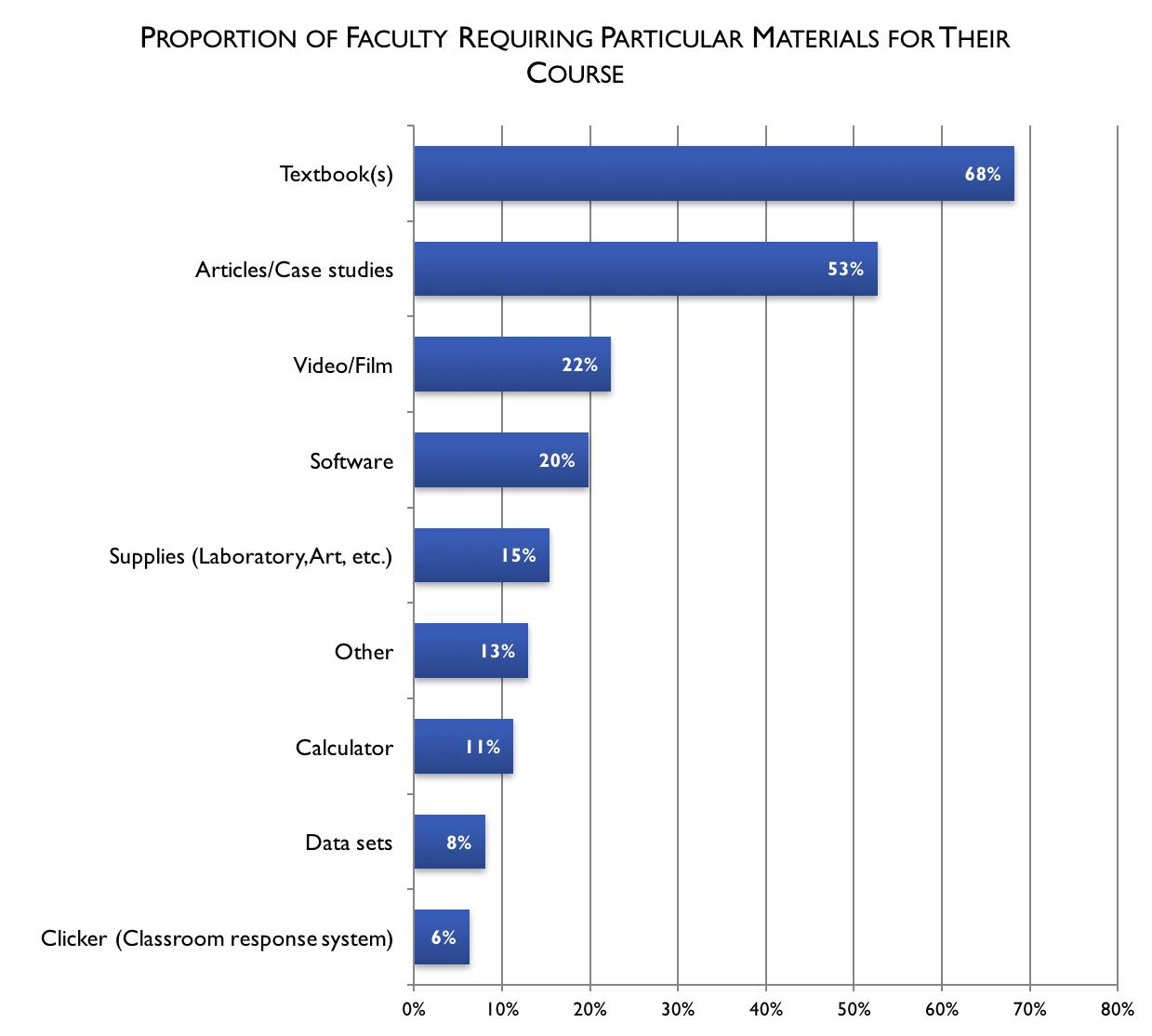 |
Faculty were asked which factors were most
important when they selected these required materials. Two factors were
mentioned as being "Very important" by a majority of faculty members:
comprehensive content and cost to the student. The most-cited factor was the
comprehensiveness of the resource (58% reporting it as “Very important” and 31%
as “Important”). This was followed by cost to the student: over one-half (56%)
of faculty said cost was “Very important,” and an additional 33% reported that cost
was “Important.” These two factors were followed by how easy it was to find
the resource (43% reported that it was “Very important” and 39% as “Important”).
The only other factor with a similar "Very important" rating was that
the material be available in print format (45% “Very important” and 30% as
“Important”).
The availability of
resources in digital format was seen as less important than print, but still
had nearly two-thirds of faculty saying it was "Very important" or
“Important”. A somewhat smaller number of faculty listed material that was
adaptable or editable, with the remaining factors mentioned by less than one
half of responding faculty members. Recommendation by other faculty members
had the lowest proportion of faculty rating as "Very important" (9%),
a rate far lower than for any other factor.
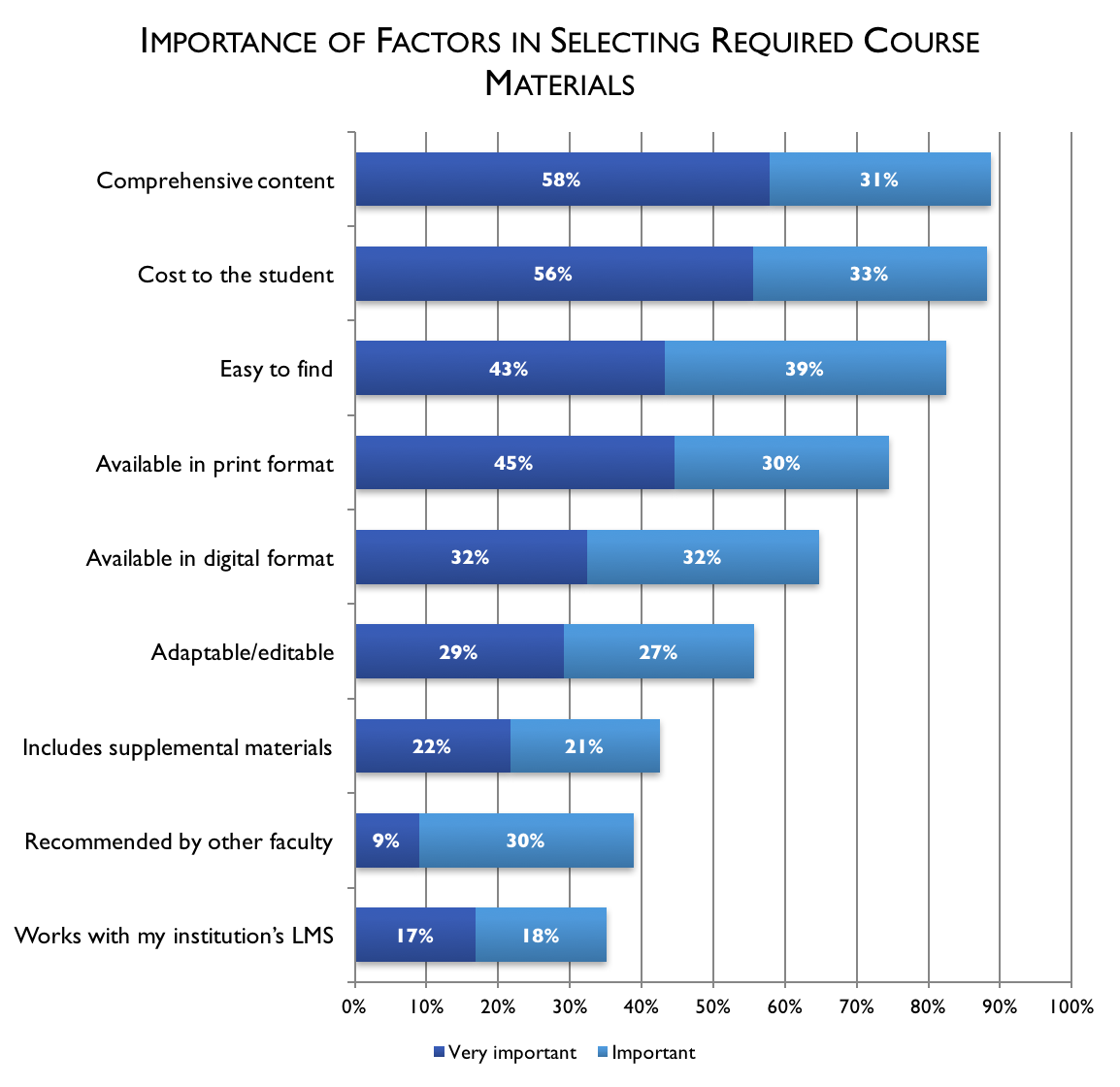 |
The relative ranking of the importance of
the different factors in the selection of required course materials has changed
only slightly from the results of last year's survey. The same top three
factors are seen as much more important than other aspects of the material for
both time periods. The proportion of faculty rating cost as important has
remained steady, while there has been an increase among those who rate
comprehensiveness of the content as important for their choice, moving it to
the number one spot.
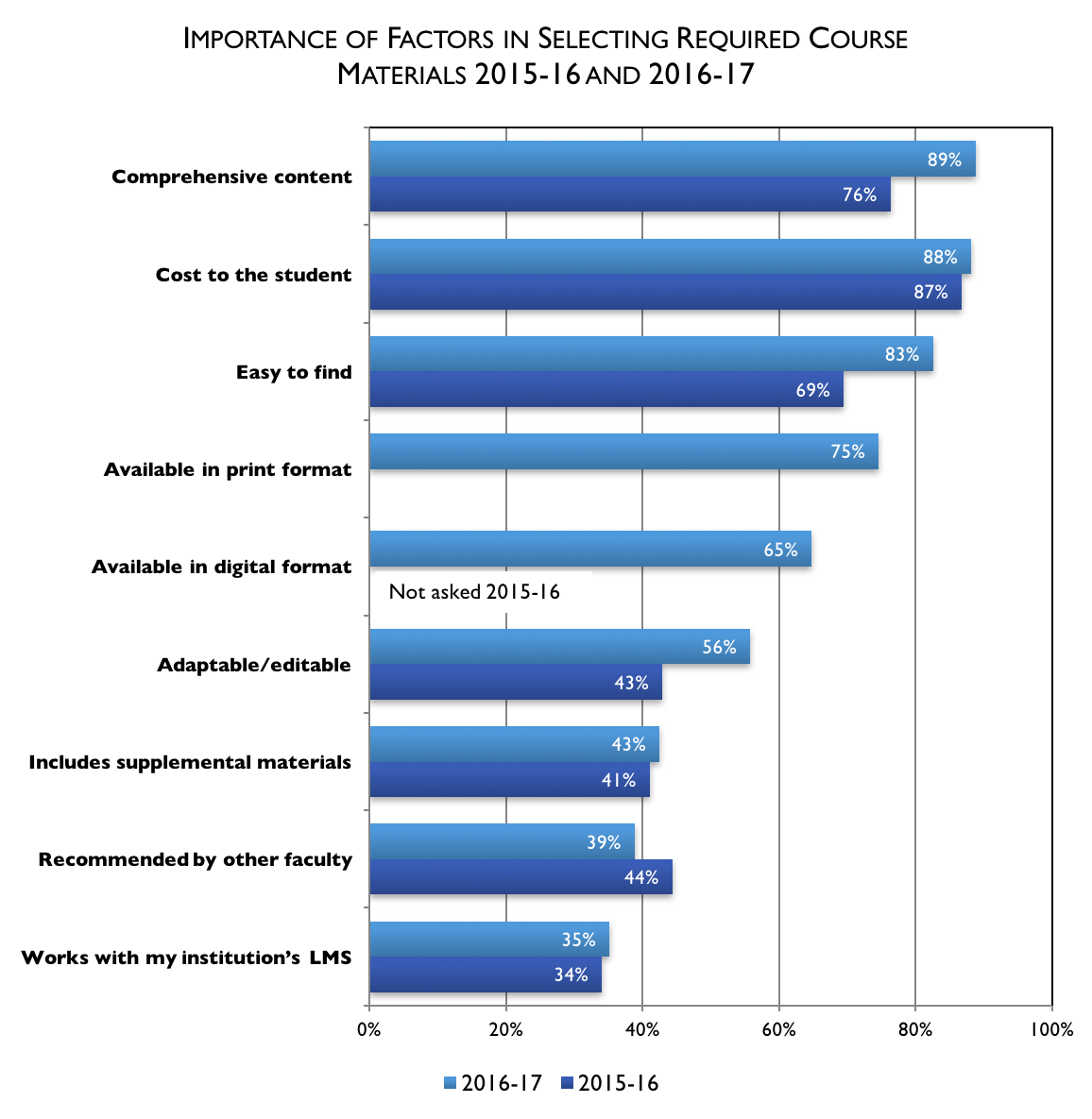 |
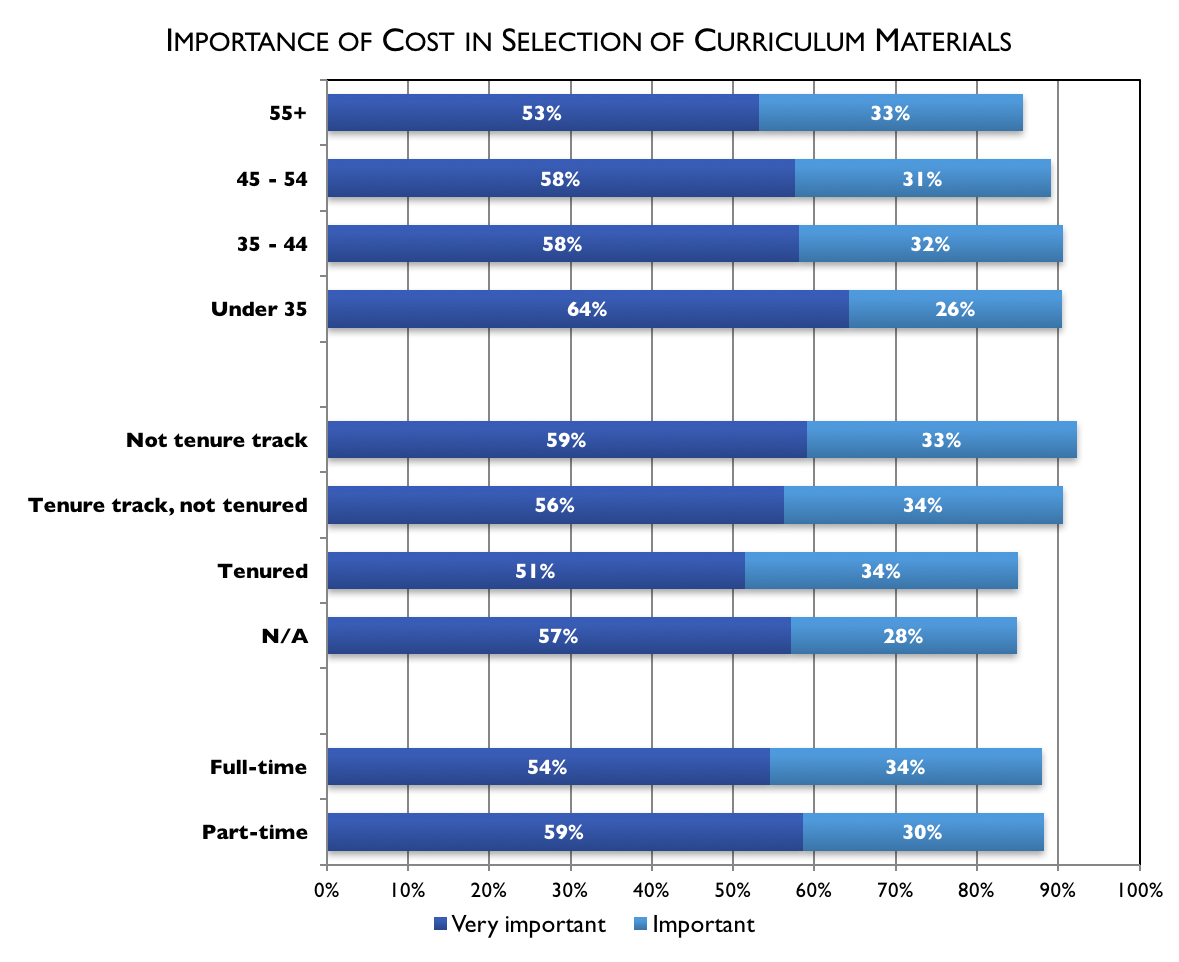 |
There has also been an increase in the
proportion of faculty reporting that materials being easy to find is important.
It remains the third-most mentioned factor, ahead of two newly included
factors. Additional growth was seen for a preference that materials be
adaptable or editable, though it remains the sixth-most mentioned factor. Faculty
comments in last year's survey displayed a considerable concern about the way
in which their materials were distributed, in particular if they were available
in print or digital form. Some faculty were enthusiastic about digital
distribution, while many others reported that their students had a preference
for printed materials. While the faculty responses do show a greater
preference for print than for digital, this is not an either/or choice. Many
faculty say that they want their materials to be available in both formats.
Cost to the Student
"About two years ago, I attended a workshop on open
access textbooks that really opened my eyes to the cost of course materials for
students. I am now reworking all of my courses to limit the cost to students. I
had no idea how many students didn't buy textbooks because of the cost."
(Full-time Social Sciences Faculty)
"I think the use of OER are the most responsible
thing we can do as educators in the face of the rising costs of higher
education. Exploration of the OER and their potential use to enhance student
engagement and learning are the future of higher education, it's time to get on
board." (Full-time Natural Sciences Faculty)
"The high cost of educational resources and
textbooks are a barrier to many of our students. It is unclear why the costs
are so high, and what is driving the costs." (Full-time Computer and
Information Science Faculty)
"It is most urgent that educators be made aware of
the day to day impact that the cost of textbooks has on our students, in terms
of everyday life as well as in terms of success and retention." (Full-time
Social Sciences Faculty)
"Over the past few years my community college
encouraged adopting OER materials. We now have many no- and low-cost courses.
Our students report how helpful this cost savings is for them."
(Full-time Liberal Arts and Sciences Faculty)
"Textbooks are becoming cost prohibitive. That
being said, I think students learn better when they have a printed resource at
the ready when they are learning. Anything that educators can do to bring the
costs of education toward a more reasonable amount should be a priority."
(Full-time Computer and Information Science Faculty)
"Textbooks have become excessive in cost, especially
the popular ones. The students complain about the cost as well as extras like
clickers." (Full-time Natural Sciences Faculty)
"The cost of text, preprinted materials is of utmost
concern to me." (Part-time Liberal Arts and Sciences Faculty)
"While a well-written and illustrated text can be an
invaluable resource for students, the current high costs of texts prohibits
many students from purchasing them. OER are wonderful, but not always reliable
as it may be that no one is responsible for correcting errors or updating the
content." (Part-time Natural Sciences Faculty)
Nearly 90% of all faculty say that cost to the
student is either "Important" or "Very important" in their
selection of required course materials. A majority of faculty classify cost as
"Very important," a finding that holds up across faculty at all
levels, all ages, and all types of institutions. However, there is a slight
trend for younger and non-tenure-track faculty to consider it more important
than older and tenured faculty.
Faculty report that the cost to the student
for their required textbook has an average price of $97 (across all levels of
courses), with a median price of $75. There is considerable variability by
discipline, with faculty in Health and related fields saying that their
textbook averages $182, while those in Computer and Information Science say
their students are spending only $68, on average.
With a majority of faculty saying that cost
is very important in their selection, and also reporting that the average cost
for their students is near one hundred dollars, it may not surprise to find
that faculty are not very satisfied with the cost of textbooks. Only 22% of
all faculty say that they are "Very satisfied" with the cost of their
selected textbook. An additional 37% report that they are "Satisfied".
Faculty in Health and
related fields may have the highest average textbook cost, but they also report
the greatest proportion of faculty who are satisfied with the cost of their
selection. Additionally, the Professional faculty with the second highest
average textbook cost also show a majority satisfied with cost. They appear to
believe that the product is worth the cost. A majority of faculty in Social
Sciences, Liberal Arts and Sciences, and Computer and Information Science with
the lowest average textbook cost report that they are satisfied with the cost
of their selected textbook. Faculty in Business, Education, and Natural
Sciences are the only segment where less than a majority report being satisfied
with the cost.
Nearly 90% of faculty
say that cost is “Important” or “Very important" for their selection, and
the majority of that faculty say they’re satisfied with the cost. So how is
student access to the required materials affected? If costs were keeping
students from having access to the required materials, we would expect that
faculty would tell us that most or all of their students had purchased the
text.
Only slightly more than
a third of all faculty say that 90% or more of their students have purchased
the required textbook. The remaining 64% of faculty report that less than 90%
of their students made the purchase, and 44% of faculty say that less than 80%
of their students that purchased the required textbook. Faculty at two-year
institutions report a higher number of students purchasing the required textbook
(42% at two-year institutions, as compared to 34% at four-year institutions
saying at least 90% had made the purchase).
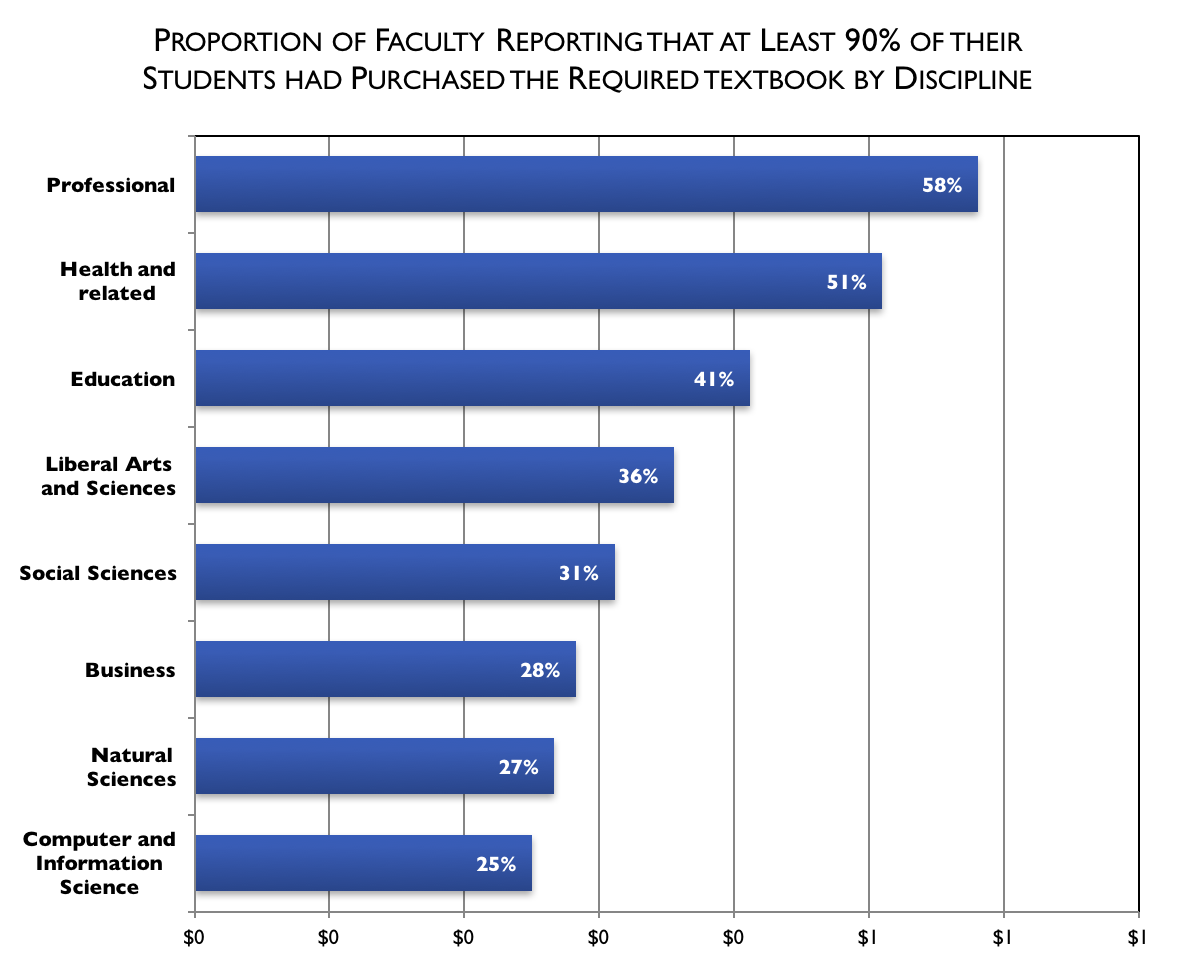 |
The two areas with the highest average cost
for required textbooks (Professional studies, and Health and related fields)
also report the greatest levels of success in having all of their students
purchase the required textbook. These are the only disciplines where a
majority of faculty believe that 90% or more of their students have purchased
the required text. Only one quarter of faculty in Business, Natural Science,
and Computer and Information Science faculty believe that 90% or more of their
students have purchased the required text.
Awareness of Open Educational Resources
"I am not fully aware of the content available
through OER but I will take a look. I am always interested in getting the right
materials into my students' hands." (Part-time Business Faculty)
"Many of the faculty at my institution do not seem
to be aware of OER, although faculty are aware of the financial challenges our
students face. I have found the quality of materials to be excellent and now
use them in all of my physics and math classes." (Full-time Computer and
Information Science Faculty)
"My awareness of OER is limited. I am sure that if
I knew more about them, then I would use them more." (Full-time Social
Sciences Faculty)
"I don't know anything about OER, but I would be
interested in knowing more about it." (Full-time Liberal Arts and
Sciences Faculty)
"I may have used OERs, but don't know them by that
name. I look forward to learning more - I just searched online and will read
up!" (Full-time Natural Sciences Faculty)
Many faculty members
have only a vague understanding of the details of what constitutes open
educational resources. Some confuse “open” with “free,” and assume all free
resources are OER. Others confuse “open resources” with “open source,” and
assume OER refers only to open source software. Because of these differing
levels of understanding, the phrasing of the awareness question needs to be
specific. The question should provide enough of the dimensions of OER to avoid
confusion, without being so detailed that the question itself educates the
respondent sufficiently that they could claim to be “aware.”
Multiple question wordings were tested for the earlier reports in this
series. A question with broad definitions but no examples was found to be more
precise than a question just using the term “open educational resources.”
Adding a series of detailed examples of OER was even more precise, but proved
too leading for the respondents and artificially boosted the proportion that
could legitimately claim to be “aware.” The version used here was found to have
the best balance in differentiating among the different levels of awareness, while
avoiding leading those with no previous knowledge of the concept.
This question wording has been used for the past two years so that year-to-year
comparisons can be made.
When faculty members were asked to self-report
their level of awareness of open educational resources, a majority (56%) said
that they were generally unaware of OER (“I am not aware of OER” or “I have
heard of OER, but don't know much about them”). These results were confirmed by
faculty comments, and some showed excitement or desire to learn more. Only 10% reported
that they were very aware (“I am very aware of OER and know how they can be
used in the classroom”), and twice that many (20%) said that they were aware
(“I am aware of OER and some of their use cases”). An additional 15% of
faculty reported that they were only somewhat aware (“I am somewhat aware of
OER but I am not sure how they can be used”).
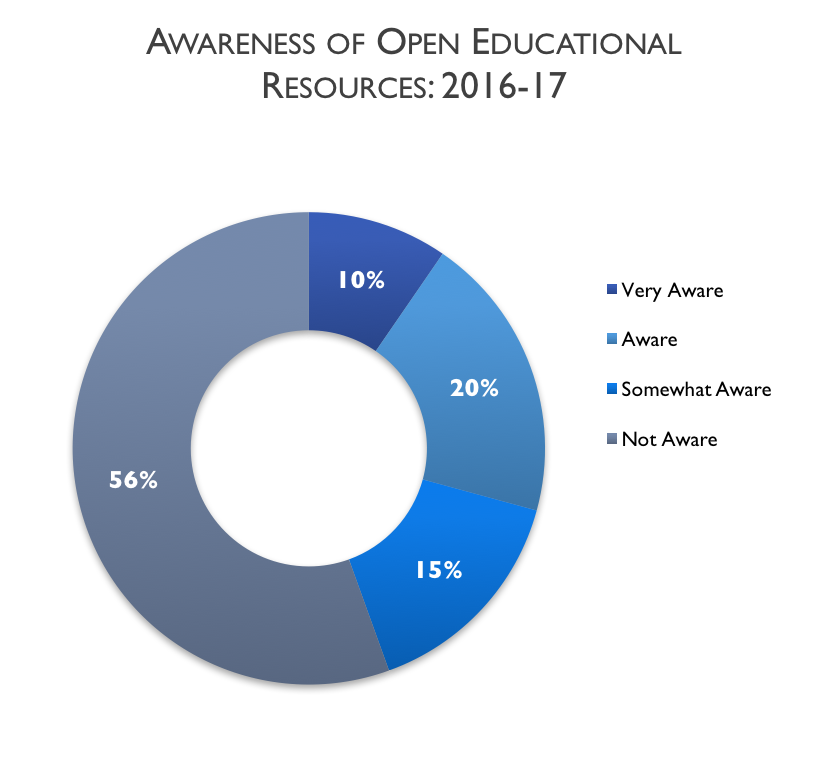 |
The 2016-17 results reinforce the trend of increased
awareness of OER observed over the past two surveys. Faculty claiming to be
very aware doubled from 5% in 2014-15 to 10% in the most recent year. Those saying
that they were “aware” grew from 15% to 20%, and those “somewhat aware” from 14%
to 15%. The proportion that reported no awareness dropped from nearly
two-thirds (66%) in 2014-15 to just over 50% (56%) this year.
Awareness of Licensing of Open Educational Resources
"I have worked in the publishing industry and I am a
published author and I'm very concerned about copyright infringement with open
source materials." (Full-time Natural Sciences Faculty)
"I'm not sure whether the images that I find as
results of Creative Commons searches qualify as OER, or if OER is separately
labeled as such, and searchable that way. I plan to look into these resources
and use them in the future." (Full-time Natural Sciences Faculty)
"While I appreciate the efforts of others to create
open access materials via various kinds of licenses, I question who will pay
for this kind of labor in the future as the university employment model changes
increasingly towards adjunct and other limited responsibility contracts in lieu
of tenure." (Full-time Computer and Information Science Faculty)
Open
licensing and the ability to reuse and remix content is central to the concept
of open educational resources. It is therefore critical
to understand faculty awareness of these concepts. Most faculty continue to
report a high degree of awareness of copyright status of their classroom
content (84% “Very aware” or “Aware”), with 96% expressing some degree of
awareness. Awareness of public domain is also very high, with over 90% of
respondents reporting some degree of awareness. The level of awareness of
Creative Common licensing, on the other hand, is somewhat lower. Less than
one-half of faculty say that they are either "Very aware" (19%) or
"Aware" (28%), and only 71% report any level of awareness.
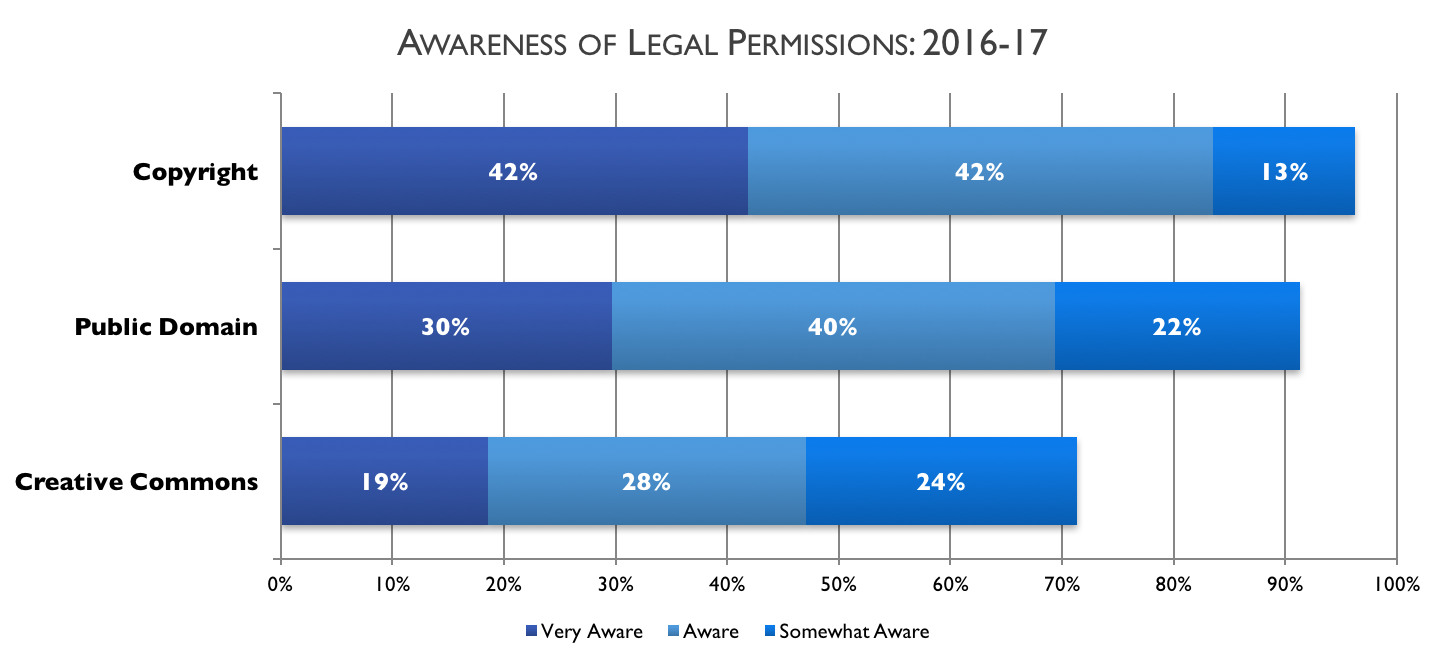 |
Awareness levels have been increasing for all three legal permissions. The 84%
reporting that they were “Very aware” or “Aware” of copyright is a small increase
over the 80% rate reported last year, and the 78% rate the year before. Awareness
of public domain increased very slightly, with “Very aware” or “Aware” totals
growing from 69% this year compared to 67% last year and 68% the year before. Awareness
levels of Creative Commons have increased the most, with the number of faculty reporting
that they were “Very aware” or “Aware” now at 47%, up from 38% last year and
36% the year before that.
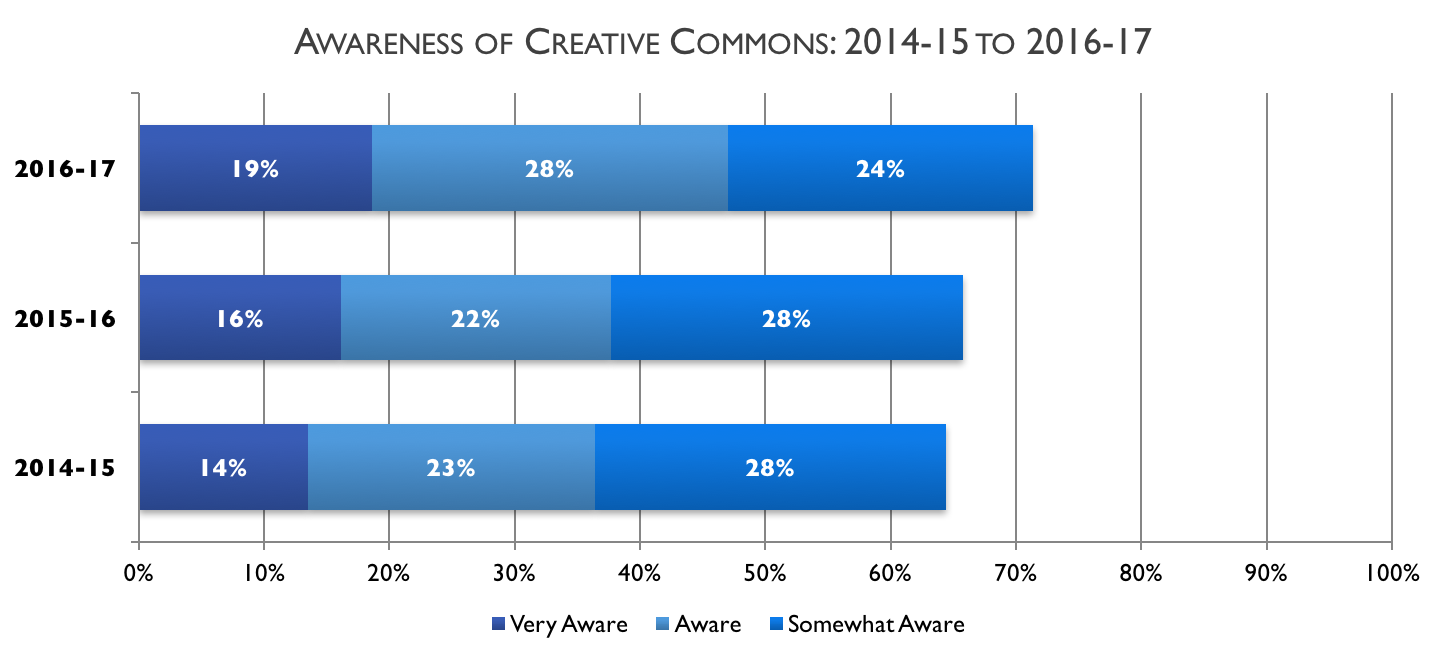 |
Given that faculty members may have only a
“fuzzy” understanding and awareness of open educational resources, a more
precise understanding of that level of understanding and awareness can be
gained from examining a combination of responses. Examining the difference
between faculty who report that they are aware of OER and faculty who report
that they are aware of both OER and Creative Commons licensing provides
a good indication of the depth of understanding of OER among faculty members.
If faculty who report that they are unaware of Creative Commons licensing are
removed for any of the “Aware” categories of the measure of OER awareness, we
create a much stricter index of OER awareness.
The level
of OER awareness drops when we apply this stricter definition, but only
somewhat. Those classified as “Very aware” dips from 10% to 8%, “Aware” from 20%
to 17%, and “Somewhat aware” from 15% to 12%. The overall proportion
classified into any of the “Aware” categories changes from 44% when awareness
of Creative Commons is not required, to 37% when it is.
The level
of combined awareness of OER and Creative Commons has increased each year. Faculty
reporting that they are "Very aware" increased from 5% in 2014-12 to
8% in 2016-17. Likewise, those reporting that they are "Aware" grew
from 12% to 17% over this same period. The total percentage of faculty claiming
some degree of awareness using this stricter definition increased from 26% in
2014-15 to 34% in 2015-16, and finally to 37% in 2016-17. This may correlate
with faculty exposure to digital copyrights, OER, and other online material
with the increasing preference and usage of digital course materials.
Digital versus Print
"Students still prefer printed textbooks."
(Full-time Natural Sciences Faculty)
"Textbooks are becoming cost prohibitive. That
being said, I think students learn better when they have a printed resource at
the ready when they are learning." (Full-time Computer and Information
Science Faculty)
"My experience with digital materials assigned in
many courses does not suggest that all students will actually do the reading
whether in print or digital form." (Full-time Social Sciences Faculty)
"Both the printed and digital versions of the book
present pros and cons in students' ability to learn course topics. The reality
is many students may not always utilize the ebook, ematerials daily if there is
limited to no access to a smartphone or no in-home Internet services. Many
students often do not bring a laptop to use during class/lecture, so this makes
it difficult to follow along using the ebook/printed textbook." (Part-time
Social Sciences Faculty)
"I do not use electronic devices in my classroom and
do not permit my students to use anything except print materials in my classes."
(Full-time Liberal Arts and Sciences Faculty)
"I have surveyed all of my classes for student
preference with regards to textbooks. Overwhelmingly, students indicated a
preference for print versions (70-95%)." (Full-time Natural Sciences
Faculty)
"Students really want the option of a print version,
even if the online version is free." (Full-time Social Sciences Faculty)
"I used an OER for one semester of Intro. to
Microbiology. The feedback from the students was that the majority wanted a
print book." (Full-time Natural Sciences Faculty)
"I want my students to save money, but I teach at a
community college and most students are not disciplined enough to pull the book
up on the computer. They are getting better, however. Many still need to see
the printed words on a page. I am also concerned with online resources not
having things such as a table of contents, glossary (important to my students),
index, etc." (Full-time Natural Sciences Faculty)
Both
commercial publishers and the OER community provide many different sets of
course materials in digital formats. In some cases, these are part of a
subscription service which students access online during the course. At other
times, the material is provided as a free download. Faculty have mixed opinions
about the relative merits of digital versus print, with roughly equal numbers saying
that they prefer each alternative. The largest group, however, report that
they are neutral.
Many
faculty do not see the choice between digital and print as mutually exclusive. They
often state that prefer to have the choice, and that they prefer for their
students to have that choice as well. Faculty comments reflect a potential
disconnect, with faculty consistently mentioning the use of digital materials
as a means to reduce costs, while at the same time reporting that their
students still strongly prefer printed materials.
There is a strong pattern by age in the
preference for digital materials over print, with older faculty much less
inclined to prefer digital than younger faculty (26% for those over age 55 as
compared to only 41% for those under age 35). This result might imply a
growing acceptance of digital, as additional younger faculty begin teaching.
As might be expected, there is also a strong pattern by discipline in the
preference for digital materials over print. Faculty teaching in the Social
Sciences are the least likely to show a preference for digital (22%). Those
teaching Business and Natural Sciences also show little enthusiasm for digital
materials. Faculty teaching in Professional programs, on the other hand, are
much more positive towards digital, with a preference rate nearly twice that of
those in Social Sciences (40% preferring digital over print).
Educational Resource Decision Process
It is
important to focus on specific faculty decisions, not hypotheticals. Faculty in
this study were asked about three different activities that represent the
faculty member making a decision on the required materials for a particular
course: creating a new course, substantially revising an existing course, or
adding or changing required course materials. The specific question wording
used was:
Over the
past two years, either working alone or with others, have you...
Created a
new course (A course that was not previously listed in the course catalog)
Substantially
modified an existing course (Examples include making a substantive change in
the content included in the course, changing the delivery method (e.g.,
converting a face-to-face course to online) or a similar change of this
magnitude. Do not count the normal fine-tuning to a course during its delivery
or the typical term-to-term refinements that all courses go through)
Added or
changed required course materials (Items listed in the course syllabus as
required for all students, either acquired on their own or provided to all
students through a materials fee, examples include a printed or digital
textbook, other course-complete printed (course pack) or digital materials, or
materials such as laboratory supplies)
Deciding on new or revised educational materials is a very
common occurrence for teaching faculty. The vast majority (89%) reported that
they had performed at least one of these activities over the previous two
years, and large numbers had done more than one. The most common activity was
changing required materials for an existing course (73%), followed by
substantially modifying a course (65%). While creating a new course was the
least common activity, nearly one-half of faculty (49%) had performed this
action over the previous two years.
Only those faculty who had engaged in a decision process
over the past two years were asked about their motivations and process for that
decision. Faculty who had engaged in this process for more than one course
were asked to respond based on the course with the largest enrollment. A majority
(53%) of the resulting decision processes were for a substantial revision to an
existing course, with roughly equal numbers of faculty creating a new course
(24%) and requiring new materials for a course without doing substantial
modifications (22%).
The reasons that faculty gave for engaging in the decision process varied considerably,
ranging from the need to fill a gap in the curriculum to just being bored of
teaching the course the same way for multiple years:
"I had been teaching the course for 15 years, and it
was sucking the life out of me. It needed to be rebuilt from the ground
up." (Full-time Mathematics Faculty)
"I have been away from the course for a few years
and thought now that I am teaching it again, it was a good time to rework the
course from beginning to end. Also, I want to add more digital content and an
online component to the course." (Full-time Social Sciences Faculty)
"I wanted to use a 'flipped' class in order free up
class time for students to work on problems in groups, helping me to gauge
their comfort with the material and better tailor material to their needs."
(Full-time Mathematics Faculty)
"A course cross-listed in another department was
cancelled by that department and so our department needed a new course for that
semester." (Full-time Social Sciences Faculty)
"A new online course was needed and I was asked by
our division chair to develop it." (Full-time Natural and Physical
Sciences Faculty)
"I participated in a faculty fellow program that
asked us to pilot active and engaged learning in our courses. I modified my
course to have consistent use of active learning strategies in my ESOL writing
and grammar course." (Part-time English Language and Literature Faculty)
"I took over a class from another instructor. It
was widely regarded as being too easy and lacking rigor." (Full-time
Social Sciences Faculty)
"A traditional course was changed to an online
format to better accommodate the varied schedules of the nursing students who
take it." (Full-time Mathematics Faculty)
"We wanted the course to appeal to more than just
our major students." (Full-time Computer Science Faculty)
"Student feedback and even I was not motivated to
read the assignments. It was lacking interesting ways to help students."
(Full-time Social Sciences Faculty)
"My goal is to provide students with the most
up-to-date material available. I teach from the primary research literature,
which requires me to constantly update the required material." (Full-time
Natural and Physical Sciences Faculty)
"Based on input from students and from the Graduate
Teaching Assistant, I felt the changes would be able to engage students more
fully in the material being presented and in thinking critically about the
subject matter." (Full-time Natural and Physical Sciences Faculty)
"The person who had refused to share the course for
years finally retired." (Full-time Social Sciences Faculty)
"Due to a proposal from the Teaching to Increase
Diversity and Equity in STEM from AACU." (Full-time Natural and Physical
Sciences Faculty)
"Our course was dreadful outdated, didn't work with
today's students, and was not easy to follow. It was too old-grained for
today's learners." (Full-time Natural and Physical Sciences Faculty)
"Effort to improve student retention by providing
more options for student credit." (Full-time Natural and Physical Sciences
Faculty)
"High failure rates (Full-time Natural and Physical
Sciences Faculty)
"I am bored repeating myself. Also, more
significantly, the threads of a discipline become clearer with time." (Full-time
Natural and Physical Sciences Faculty)
"I decided to participate in a university level
effort to include critical and creative testing across the curriculum."
(Full-time Computer Science Faculty)
Two-thirds (67%) of all faculty reported
that they were the sole decision maker for the new or revised course material.
An additional 22% were engaged in a group decision, with 10% being the lead and
12% acting as a member of the group.
The courses that faculty
reported on were overwhelmingly at the undergraduate level (74%). Most were delivered
face-to-face (78%), with only 14% blended and 8% online. Faculty classified these
courses primarily as an “Introductory course” (40%), but intermediate (31%) and
advanced level (28%) courses were both well represented. Because we asked
faculty who worked on more than one course to select the largest enrollment
course for their responses, the reported courses skew larger than might
otherwise be the norm. A large portion of these courses (46%) are taught in
multiple sections, a rate that goes up to 66% among the introductory level
courses.
Nearly three quarters
of the courses that faculty are reporting on are required for students, either
for all students (28%) or for selected students (e.g., majors in this discipline)
(45%).
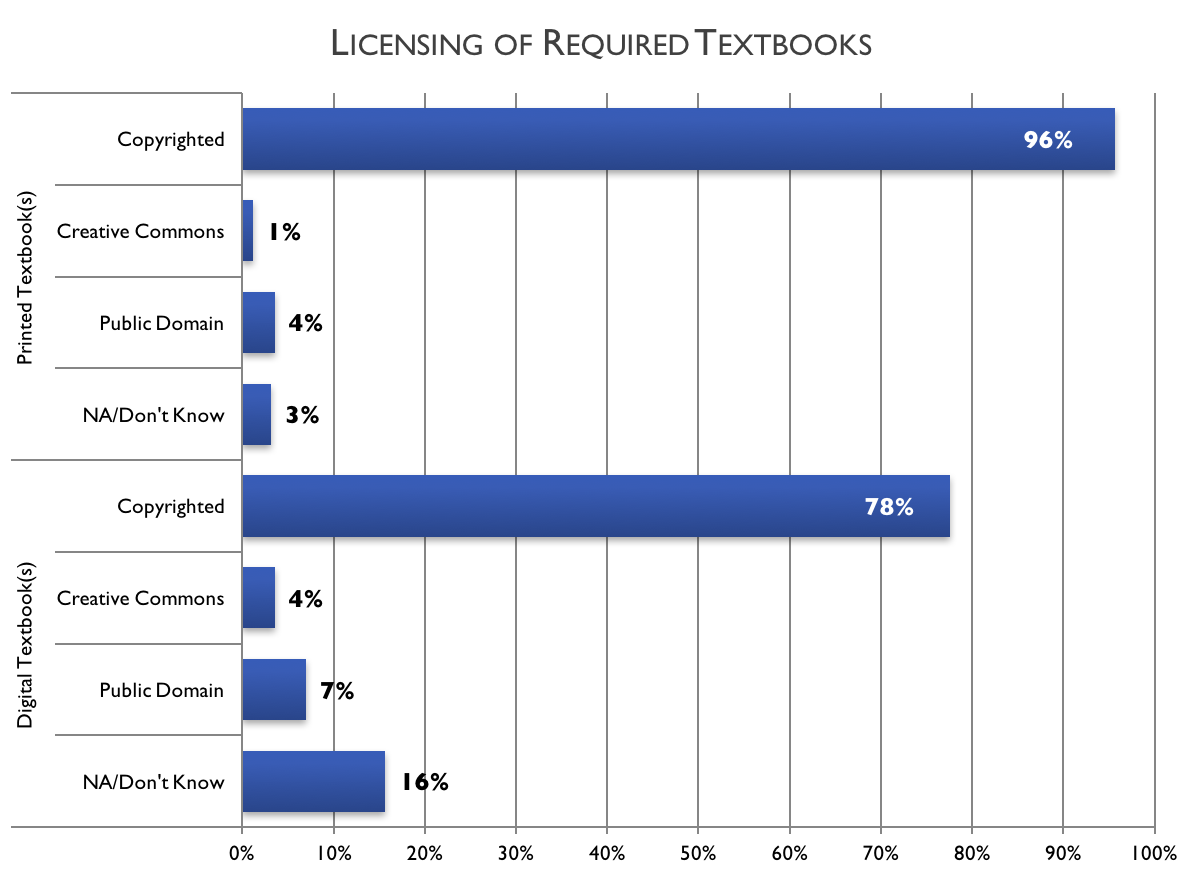 |
Faculty were asked how their required
printed and digital textbooks were licensed. Faculty overwhelmingly reported
that they were using copyrighted printed textbooks (96%), with only small
proportions stating that the text was licensed under Creative Commons (1%) or
was in the public domain (4%). The numbers for the digital version of the
textbook were also highly slanted towards copyrighted material, but at a rate
considerably lower (78%) than for print versions. The rate that faculty said that
their digital textbooks were either creative Common Commons or public domain
were higher than for printed textbooks, but the second largest group (16%) were
faculty reporting that they did not know how the digital materials were
licensed. This is well in line with earlier results showing faculty do not
have a high level of awareness of the various legal permissions that govern the
use and sharing of their required textbooks.
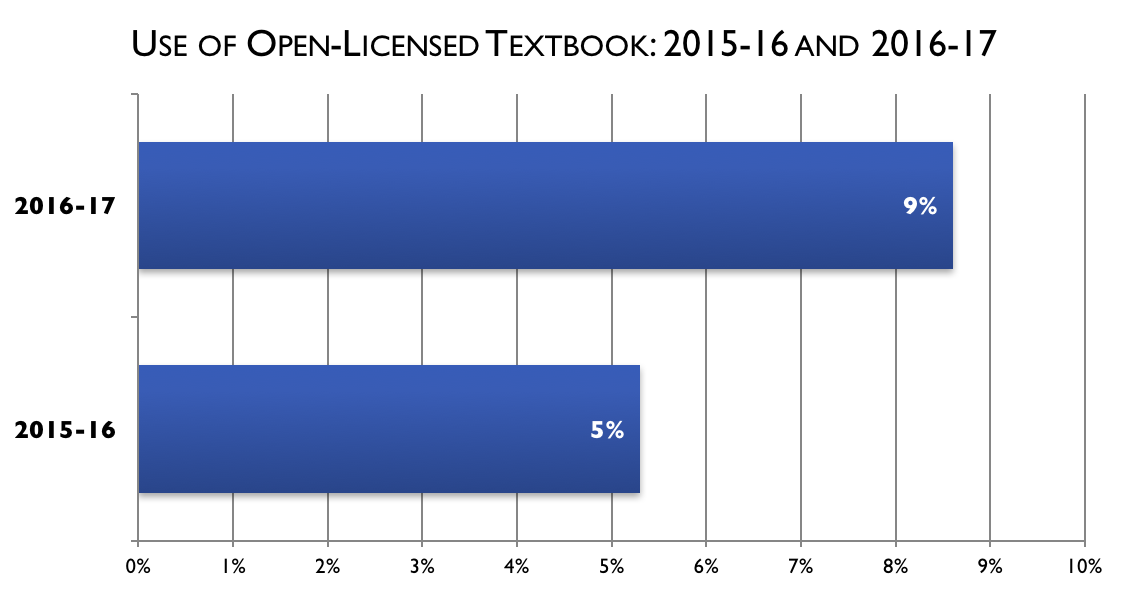 |
Only a small proportion of faculty report that they are using an open-licensed
textbook (defined as either public domain or Creative Commons). However, the 9%
rate for 2016-17 represents a substantial increase over the rate for 2015-16 of
5%. Use of open-licensed textbooks may be rare, but it is growing.
Potential Barriers
"I prefer the 'regular' publishers who have been
providing excellent resources for many, many years. I'm very old-school about
textbooks and hope I will never be forced to use OER." (Full-time Social
Sciences Faculty)
"After settling on the idea of teaching statistics
in a Simulation-based Inference manner, there were very sparse offerings in the
OER domain." (Full-time Computer and Information Science Faculty)
"I'm convinced OER is the future of education. The
reason we have such exceptional educational resources today is because
authors/publishers were motivated by $$ to build them. I would love to believe
that OER can get there (pedagogical excellence) without required avarice but so
far, I haven't seen it." (Full-time Natural Sciences Faculty)
"I am not satisfied with the current crop of OER,
creative commons, or open source resources available." (Full-time Social
Sciences Faculty)
"My chief reason for not using more 'free' textbooks
has to do with the supplemental resources and the need to 'start over' in class
design." (Full-time Natural Sciences Faculty)
"I disagree with the basic premise that more
students will get a better education if course material (or tuition) is free.
Motivation, prioritizing, and commitment seem to be the biggest factors in educational
success, so having reasonably priced, high quality materials is my
priority." (Part-time Social Sciences Faculty)
"I have found that there are problems with free
material. Massive infusion of funds to develop free material does not assure
quality." (Full-time Computer and Information Science Faculty)
"I teach detailed scientific Concepts and we require
high quality medical illustrations. From what I've seen from open source
materials, the quality of the illustrations and the accuracy of the information
is often lacking, and there have been many times that illustrates have been
lifted from copyrighted sources and presented as open source." (Full-time
Natural Sciences Faculty)
"I tried using an OER textbook in the spring. It
was a catastrophic experience. I assumed the materials would be high quality
because I have colleagues who have used OER and had good experiences. I didn't
spend much time adapting the materials for my classroom. My students' learning
suffered in response." (Full-time Natural Sciences Faculty)
The
results from this year's survey show that the most serious issues facing wider
adoption of open educational resources continues to be the effort needed to
find and evaluate suitable material. Nearly one-half of all faculty report that
“there are not enough resources for my subject” (47%), and that it is “too hard
to find what I need” (50%). These rates exceed those of any other potential
barrier. The pattern has been consistent over time, with faculty ranking the
effort needed to find and evaluate suitable material as the most critical
barriers to adoption. This has been the top issue for each of the three years
the question has been asked.
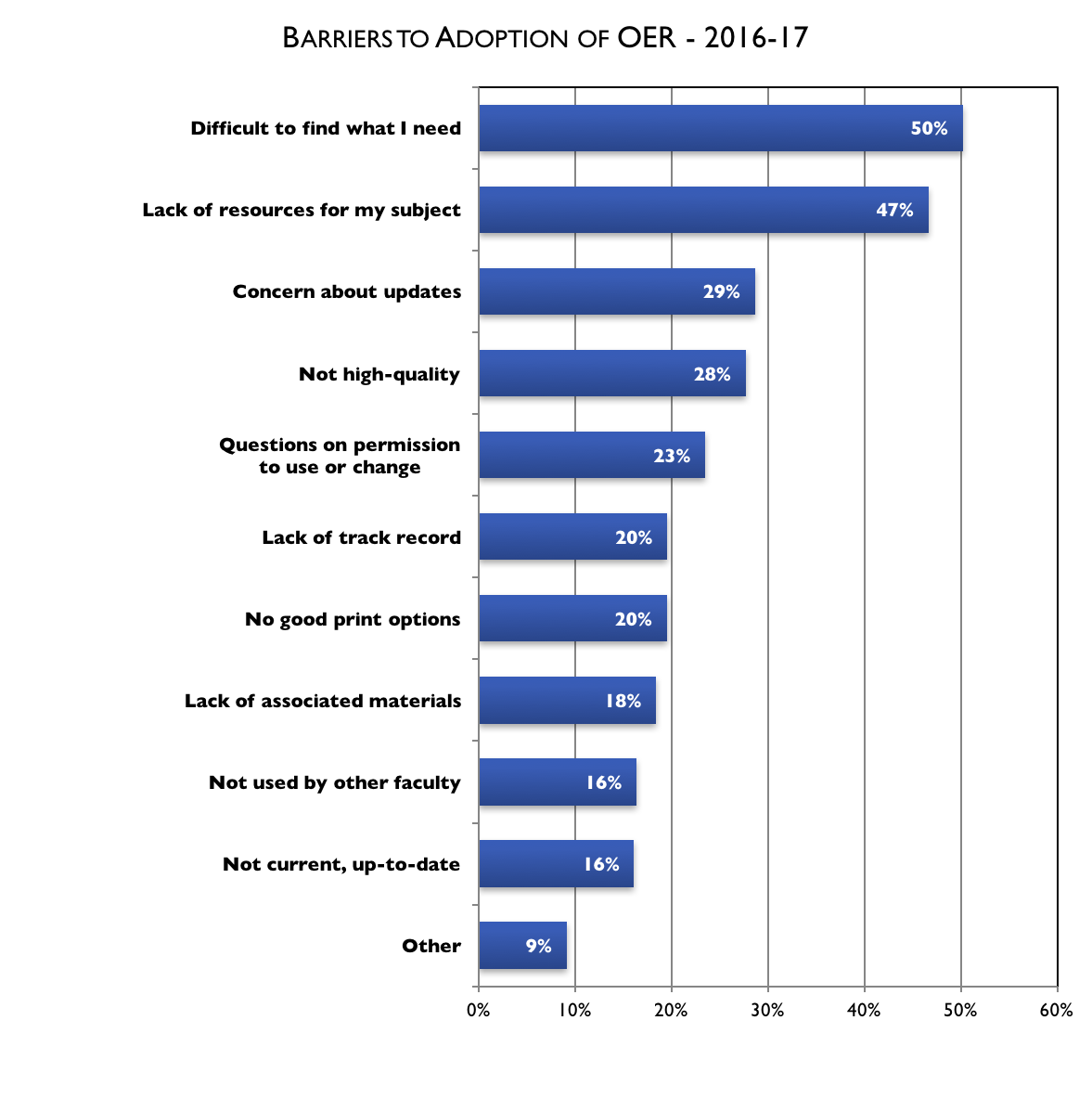 |
Many faculty members also voice concerns about the long-term viability of open
educational resources, and worry about who will keep the materials current.
The third-most mentioned barrier, "concern about updates," is also
often cited in the open-ended comments. Faculty specifically mention the lack
of a financial incentive as reason to think that there will not be regular
updates.
Concerns about quality are reflected in both the
fourth-mentioned item, "not high quality" (28%), and "not
current or up-to-date" (16%). The lack of nuanced understanding of the
full nature of open educational resources is evident in the fact that nearly
one-quarter of all faculty report that "questions about permissions to use
or change" the materials as a potential barrier to their adoption. There
also appear to be concerns about fitting in with other standards at the
department and institution, or faculty not wanting to be early adopters of OER
materials: 16% of respondents listed “not used by other faculty” as a barrier
to adoption.
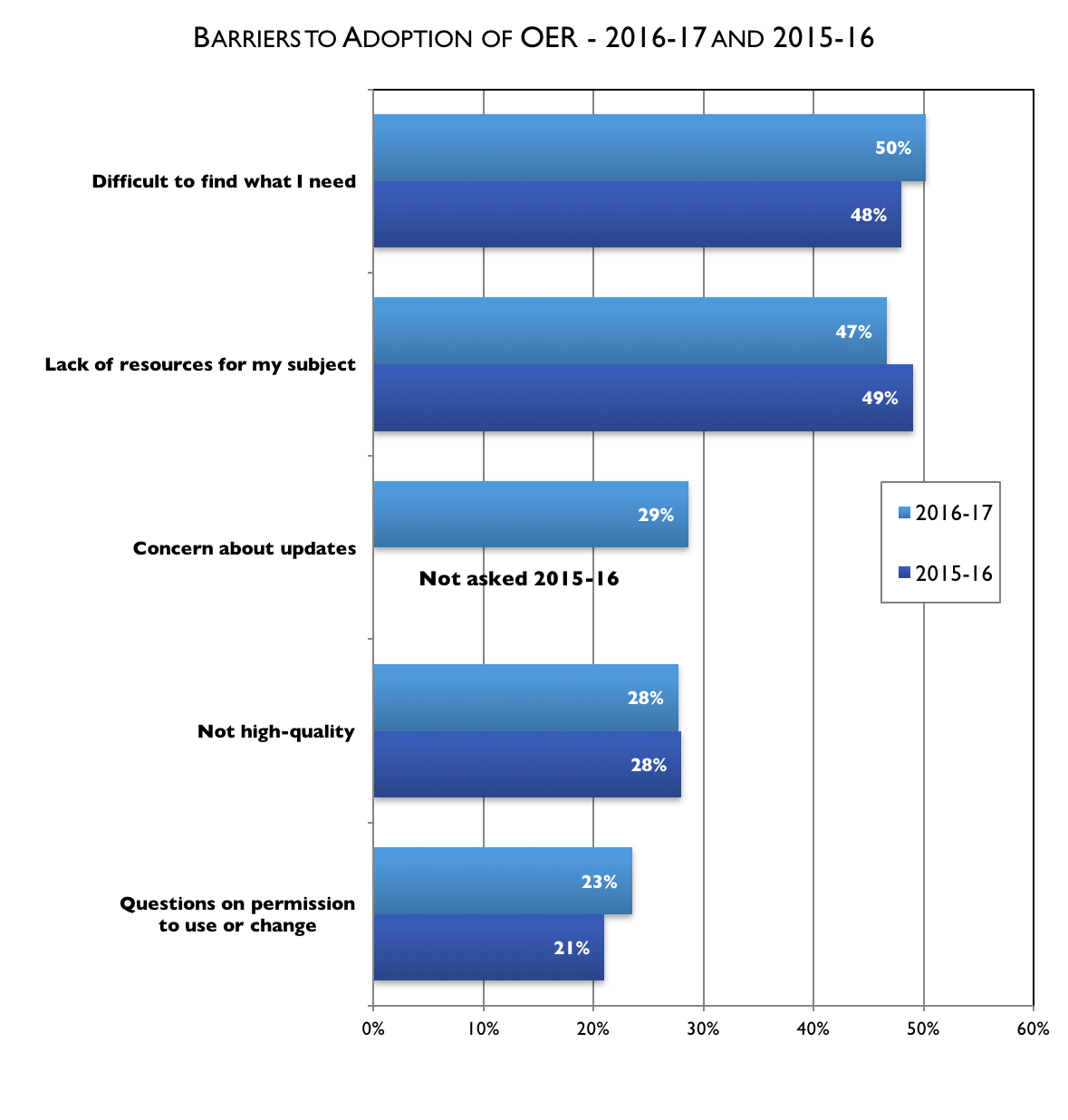 |
There has been little change among faculty perceptions of these barriers. Comparing
the 2016-17 results for the top-mentioned barriers to those reported last year
shows only the smallest changes. The top two continue to relate to the
difficulty in finding suitable resources, while concerns about quality and
permissions also remained relatively stable. The 2015-16 survey did not
include an option asking about updates to the OER materials. It was added to
the most recent survey because many faculty mentioned this in their open-ended
response to this question.
The Process of Textbook Adoption for Introductory Courses
"I think it would be great if there were free, open
access course materials for introductory courses in biology and other
disciplines. But then, I think it would be great if we had universal health
care in the U. S., too." (Full-time Natural Sciences Faculty)
"I use an OpenStax text in my introductory courses
only. I have looked at other free/OER resources, but I have not found any of
sufficient quality to use. The OpenStax book I use is not the best, but is
sufficient with supplements I provide." (Full-time Social Sciences
Faculty)
"I was very interested in using OpenStax Chemistry
but found many major errors when I read a few chapters." (Full-time
Natural Sciences Faculty)
"We are extremely happy with our adoption of the OpenStax
biology textbook. We have derived and edited our own collection. The process
allows us to customize our teaching materials." (Full-time Natural
Sciences Faculty)
"I chose the OpenStax textbook because it addressed
all my concerns about OER: print option available, high quality (not as high as
some texts, but high enough considering what I add during my class time), and
resources available (although not as much as I would like to see, but for an
experienced instructor, they are fine)." (Full-time Social Sciences
Faculty)
"We are all using OpenStax biology books. The main
issue is lack of supporting material, but that is overcome by a collection of
resources that the department has collected over the years, and is provided to
all new adjuncts." (Full-time Natural Sciences Faculty)
"I chose OpenStax because it was reviewed by the
California state committee, because it covers every topic in the course outline
of record at my college, and because it comes with a test bank (a must!)."
(Part-time Social Sciences Faculty)
"I have used OER materials from OpenStax and found
the supplements really helpful. Students really want the option of a print
version, even if the online version is free. I love the adaptability and played
around with adding content, too." (Full-time Social Sciences Faculty)
"I tried out an OpenStax text for my course this
spring and was very pleased. Especially now that I know that they do offer a
print version of the book." (Full-time Natural Sciences Faculty)
Not all faculty textbook
choices have the same level of impact. The decisions of those who teach large
enrollment introductory level courses will affect far more students than those
teaching smaller enrollment courses. OER publishers are well aware of this,
and have concentrated their offerings to serve these large enrollment courses. Faculty
members in this study who made a textbook decision for a large enrollment
introductory level course were presented with additional questions concerning
their decision. The courses addressed in this study were:
·
Algebra and Trigonometry
·
American Government
·
Anatomy and Physiology
·
Biology (majors/mixed majors)
·
Biology (non-majors)
·
Calculus
·
Chemistry (2 semester)
·
Chemistry (General)
·
College Algebra
·
College Physics (Algebra based)
·
Introductory Psychology
·
Introductory Sociology
·
Macro Economics
·
Micro Economics
·
Microbiology
·
Pre-algebra
·
Precalculus
·
Principles of Economics
·
Statistics
·
U.S. History
·
University Physics (Calculus based)
Faculty
teaching one of these courses were presented with a list of the most commonly
used commercial textbooks (up to twelve) for that specific course, along with
an open text alternative from OpenStax, a non-profit OER publisher based out of
Rice University. The choice of an OpenStax OER alternative for these
courses was made to provide a consistent set of options for all courses, so
relative adoption rates could be estimated. OpenStax has been providing texts
and ancillaries for introductory courses since 2012, and currently have an OER
offering for each of the above-listed courses.
Introductory
level courses are often taught in multiple sections (66%) and are typically
required for at least some students (79%). Faculty teaching these courses are
still the primary decision maker for selecting the required course materials. However,
the decision is made at the department or higher level 19% of the time, a rate
only slightly higher than the overall rate of 16% for all courses.
The
selection process for the large enrollment courses is very similar to that for
all courses. Faculty teaching these courses rank the importance of the various
factors in their decision in exactly the same order as the general faculty,
with only a few small differences in reported levels. The difference in rated
importance for most factors is within a few percentage points. The only ones
where there is any hint of a difference are the availability in print format
(where those teaching introductory level courses rate it 7% higher) and that
the resources work with the institution's learning management system (where
there is a similar 7% difference).
While
the relative ranking of factors used in selecting course materials is very
similar between those teaching introductory-level courses
and all other faculty, the perception of what barriers prevent them from
adopting an OER alternative are very different. Faculty teaching
introductory-level courses are concerned that it is "difficult to find
what I need" and a "lack of resources for my subject" but at a
much lower level than the overall faculty response. This is most
likely because it is exactly these courses that OER publishers have been
targeting, meaning that the range of OER options is far better for these
courses than for most others.
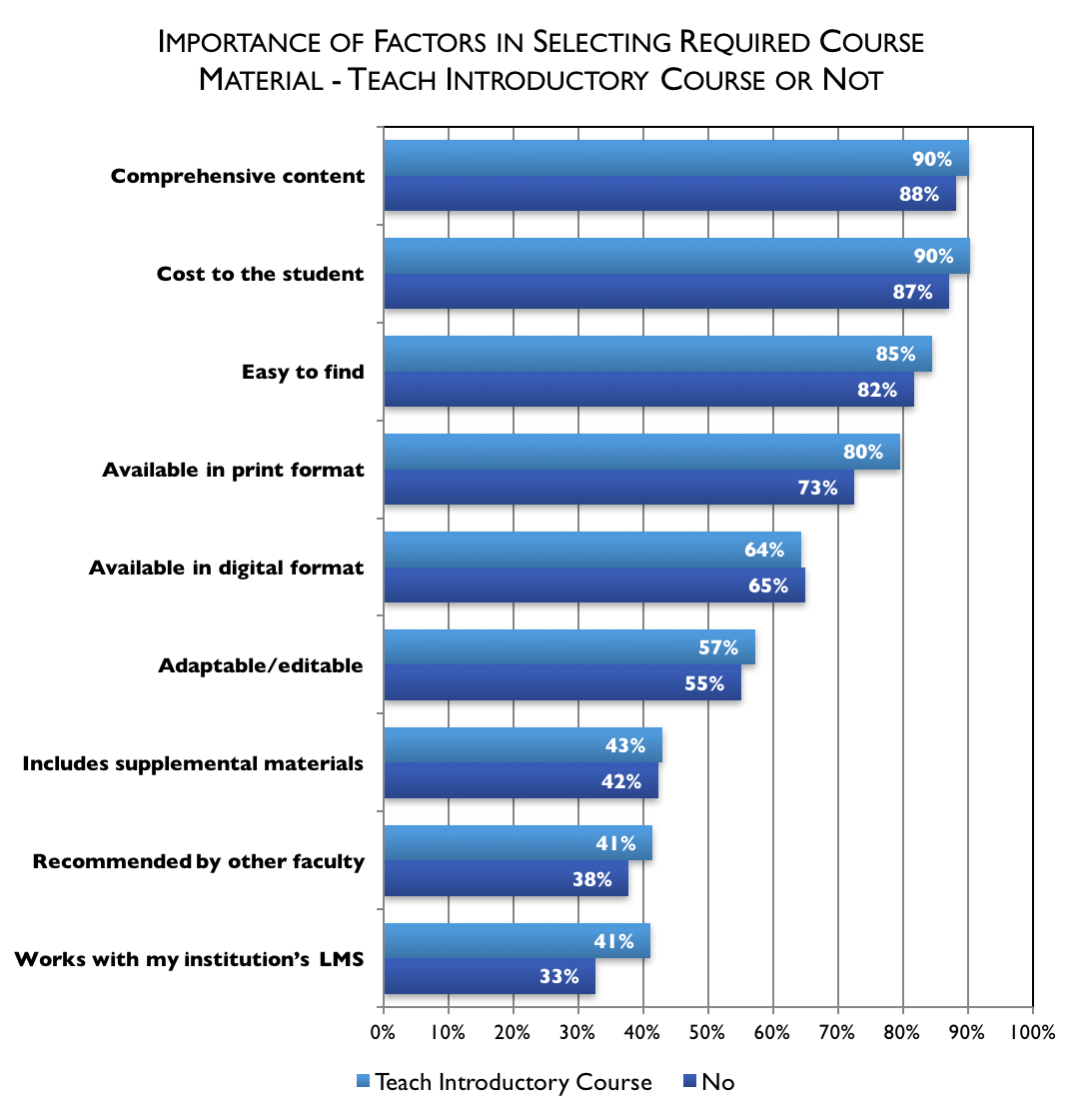 |
Faculty
teaching introductory-level courses may be more aware of OER options that are
other faculty, but that does not mean that they do not have some serious
concerns. They are more concerned that the OER alternatives are not of high
quality (36% as compared to 28% among all faculty), and very concerned about the
lack of associated materials, with a rate more than double that of the overall
faculty sample (37% compared to 18%).
The rate of adoption of OpenStax textbooks
among faculty teaching these large enrollment courses is now at 16.5%, a rate
which rivals that of most commercial textbooks. This is a substantial increase
over the rate observed in the previous year (10.8%).
All faculty were asked about their level of satisfaction with the textbook they
selected and used. Users of OpenStax textbooks had levels of satisfaction
equal to their peers teaching introductory level courses who had selected
commercial textbooks. A higher proportion of faculty using non-OpenStax
textbooks reported that they were extremely satisfied (29%, as compared to 26%
for the OpenStax users). That said, OpenStax users reported lower levels of
dissatisfaction, and higher levels of “moderate” satisfaction. Interestingly,
there were only satisfied or dissatisfied responses, and no “neutral”
satisfaction responses with OpenStax. Overall, the pattern for OpenStax users
has the majority clustered in the moderately satisfied group.
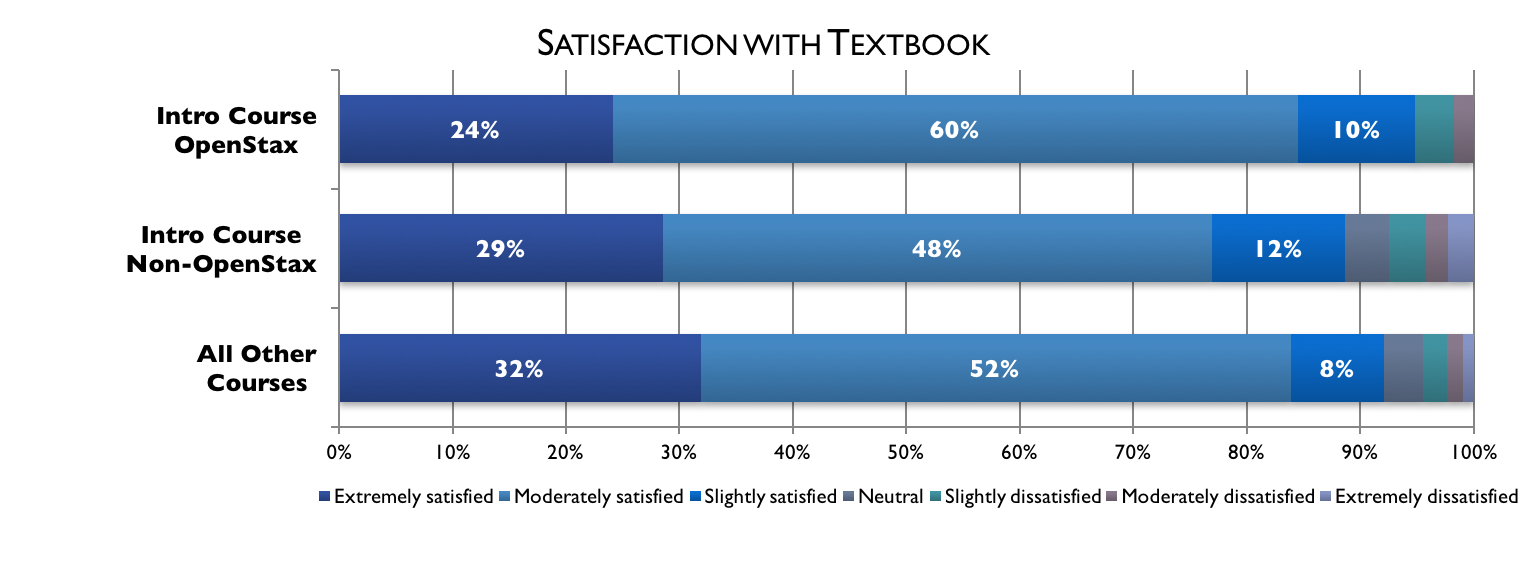 |
In addition to an overall satisfaction with their textbook
choice, faculty were asked about their level of satisfaction with a number of
specific aspects of their choice. With the single exception of the dimension
of cost, where the OpenStax users were far more satisfied, levels of
satisfaction were very similar among faculty teaching introductory level
courses between those who adopted an OpenStax textbook and those who had
selected something else.
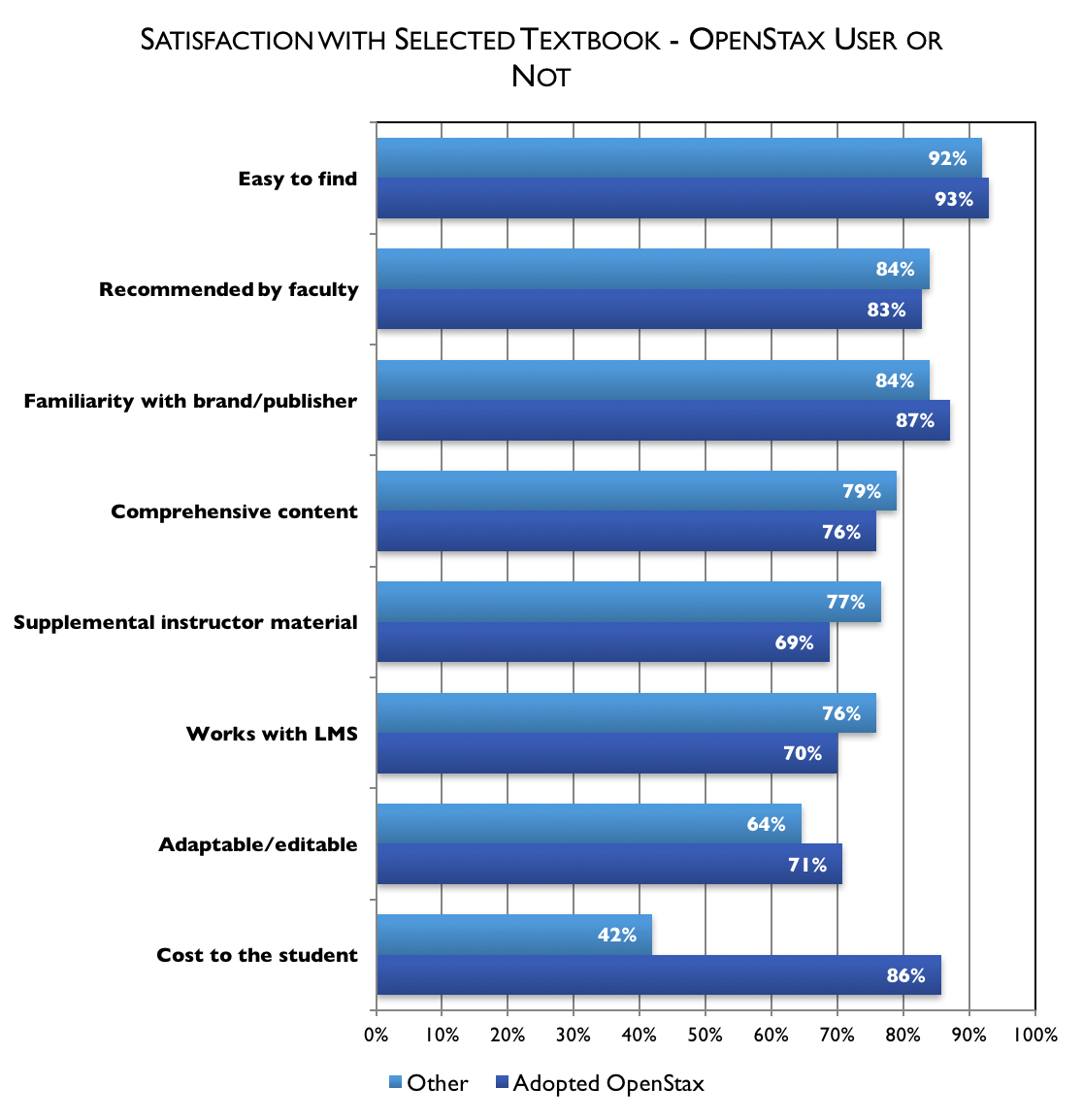 |
The higher level of satisfaction with cost to the student is evident in faculty's
reported textbook costs. Faculty teaching large enrollment introductory
courses who did not select an OpenStax textbook reported an average cost of
$125 for the required textbook. Those who selected an OpenStax text reported
an average cost of $31. This is also reflected in faculty perceptions of how
many of their students purchased all the required textbooks for the course. The
median rate reported by faculty who did not select an OpenStax textbook was
85%, while the rate among those who did select an OpenStax textbook was 92%.
Are
faculty who select an OpenStax textbook different from other faculty? Faculty
were asked to rate themselves on a scale of how much they used existing
materials and how much they created new materials for their classes. Faculty
who adopted an OpenStax textbook are similar to their peers on this dimension,
with a majority reporting that they develop their own curriculum.
The picture is very different when faculty
report on their teaching styles, however. A majority (51%) of faculty who
adopted an OpenStax textbook say that they prefer facilitated exploration
(which compares to only 28% among those who did not adopt an OpenStax
textbook). OpenStax adopters are only half as likely to say they prefer
lectures as those who did not adopt.
OpenStax adopters are also far more
comfortable with digital materials. They are twice as likely to prefer digital
over print (39% compared to 18%), while their peers tend to prefer print (34% for
print compared to 25% who prefer digital).
Future Use
"Free resources cannot compete with customize
updated textbooks and websites made available by commercial publishers with
proven authors." (Business Faculty)
"I want to use open source materials. My first
foray into it was disappointing." (Full-time Social Sciences Faculty)
"There is no OER for Human Biology for non-biology
majors specifically. That is why I have yet to use it. There is only a
general biology text so far." (Full-time Natural Sciences Faculty)
"Lack of ongoing payment to authors means open
material is almost never well maintained." (Full-time Computer and
Information Science Faculty)
"OER sounds fascinating." (Full-time Computer
and Information Science Faculty)
"My focus is research and doctoral advising. I
should look for open resources but the time it takes versus the reward and
expectations make putting in the time an un-rewarding proposition. Neither
students nor colleagues bring it up, so why invest the time?" (Full-time
Education Faculty)
"When I looked at the available OER a few years ago,
I found the search clumsy and the materials a bit outdated. I would more often
consider OER if it was easier to find what I need and to build a course around
it." (Full-time Liberal Arts and Sciences Faculty)
Faculty
members who are not current users of open educational resources were asked if
they expected to be using OER in the next three years. Only 6% reported that
they were not interested, while an additional 15% had not yet decided and were
unable to offer an opinion. A small number of faculty claim that they will use
OER in the future (7%), while a larger group (37%) say that they will consider
future OER use.
There has been no change in the proportion of faculty who report that they will
use OER in the next three years, remaining at the same 7% this year as it was
in 2015-16. There has been an increase in the number who report that they
"Will consider" OER, growing from 31% in 2015-16 to 37% this
year.
The
results from this year's survey show strong growth in the proportion of faculty
selecting OER for their large enrollment introductory-level courses. This has
been coupled with small to moderate levels of growth in:
·
Self-reported OER awareness
·
Awareness of legal permissions
·
Combined awareness of OER and legal permissions
·
Proportion reporting that they "Will consider" OER in
the future
OER
remains a minority (or even niche) product among higher education teaching
faculty. Even in the area where it is strongest - large enrollment
introductory-level courses - it still represents only a small portion of
faculty selections. The trends over the past three years, and the stated
willingness of additional faculty to consider it in the future, suggests
continued but moderate growth.
METHODOLOGY
A national faculty
sample is used in this analysis, designed to be representative of the overall
range of faculty teaching in U.S. higher education. A multi-stage selection
process was used for creating a stratified sample of all teaching faculty. The
process began by obtaining data from a commercial source, Market Data Retrieval,
which has over one and a half million faculty records and claims that its
records represent 93% of all teaching faculty. All faculty who taught at least
one course were selected for this first stage. Faculty were then randomly
selected from the master list in proportion to the number contained in each
Carnegie Classification, to produce a second-stage selection of teaching
faculty members. This sample was then checked against opt-out lists, as well as
for non-functioning email addresses.
A total of
2,711 faculty responded to a sufficient number of questions to be included in
the analysis, representing the full range of higher education institutions
(two-year, four-year, all Carnegie classifications, and public, private
nonprofit, and for-profit) and the complete range of faculty (full- and
part-time, tenured or not, and all disciplines). More than 73% of the
respondents report that they are full-time faculty members. Over 26% teach at
least one online course and 28% teach at least one blended course.
Institutional descriptive data come from the National Center for Educational
Statistics’ IPEDS database. After the data were compiled
and merged with the IPEDS database, responders and nonresponders were compared
to ensure that the survey results reflected the characteristics of the entire
population of schools. The responses are compared for 35 unique categories based
on the 2015 Carnegie Classification of Institutions of Higher Education.
Analysis
for this report has been conducted for three different subgroups of the survey
respondents:
·
A series of questions were directed to all responding faculty
(all teaching faculty) on such issues as their criteria for selecting
educational resources, awareness of openly licensed resources and open
textbooks, future plans, etc.
·
A second set of more detailed questions were directed only to
those faculty members who had been through a decision process related to course
materials over the past two years. Approximately 89% of all responding faculty
qualified for these questions because they had created a new course,
substantially modified an existing course, and/or selected new required course
materials.
·
A final set of textbook selection questions was directed at faculty
members who had recently been through the decision process for a large
enrollment undergraduate course. These faculty were presented with detailed
lists of possible textbooks that they may have considered, to determine which
books they considered and adopted.
The wording of the
question is critical in measuring the level of OER awareness. Many academics
confuse “open” with “free,” while others confuse “open resources” with “open
source,” and assume OER refers only to open source software. The wording of
the question for this report matches that used in previous reports in this
series.
The wording used (listed below) was found to have the best
balance in differentiating among the different levels of awareness, while
avoiding leading those with no previous knowledge of the concept.
How aware are you of Open Educational Resources (OER)? OER is
defined as "teaching, learning, and research resources that reside in the
public domain or have been released under an intellectual property license that
permits their free use and re-purposing by others." Unlike
traditionally copyrighted material, these resources are available for "open"
use, which means users can edit, modify, customize, and share them.
*
I am not aware of OER
*
I have heard of OER, but don't know much about them
*
I am somewhat aware of OER but I am not sure how they can be used
*
I am aware of OER and some of their use cases
* I am very aware of
OER and know how they can be used in the classroom
Based on our testing,
the results from this question may still slightly overstate the level of OER
awareness, but this was considered a better option than leading the
respondent. By using a series of additional questions, the results from this
question can be adjusted to remove those who might have thought that they were
aware of OER, but when probed did not have knowledge of all of the aspects that
make up the concept.
Because licensing for remixing and reuse is central to the
concept of OER, a question about the respondent’s awareness of different legal
permissions was asked of all respondents before any questions about OER
awareness itself:
How aware are you of each of
the following licensing mechanisms?
|
|
Unaware
|
Somewhat Aware
|
Aware
|
Very Aware
|
|
Public Domain
|
|
|
|
|
|
Copyright
|
|
|
|
|
|
Creative Commons
|
|
|
|
|
By combining the responses from the OER awareness question
with those of the licensing questions, a combined index of awareness can be
constructed. This process was also used in previous reports in this series, to
permit year-to-year comparisons and trend analysis.
![]()




